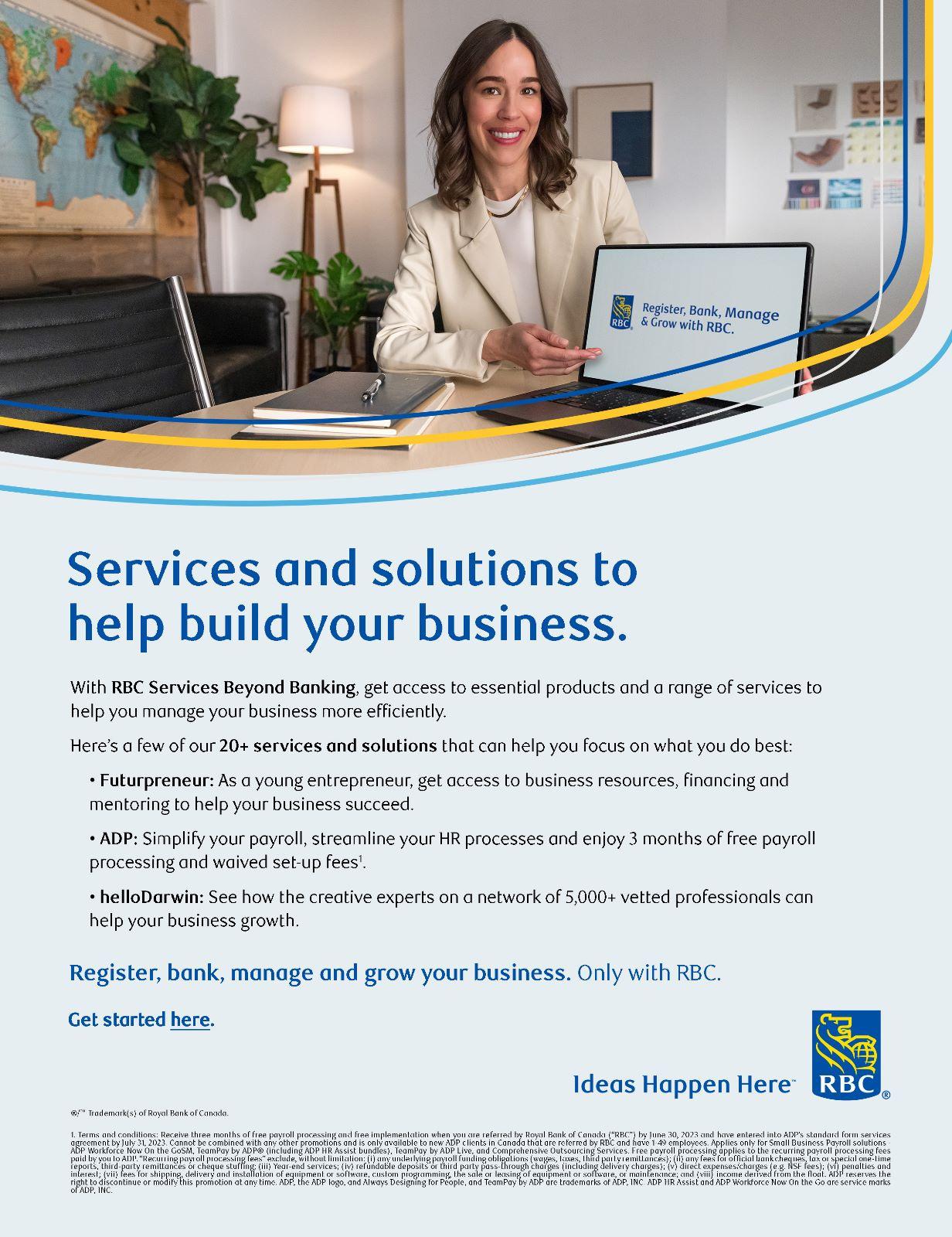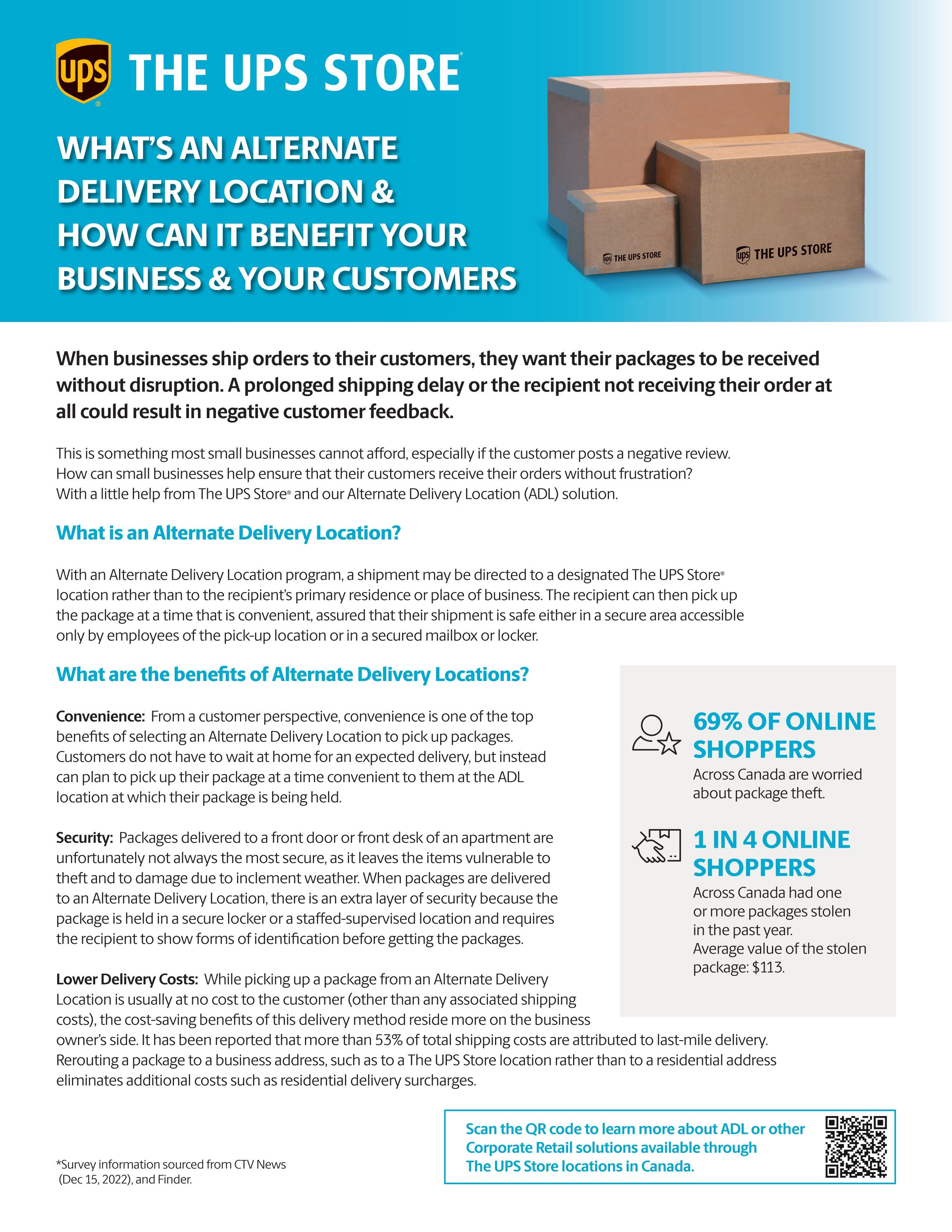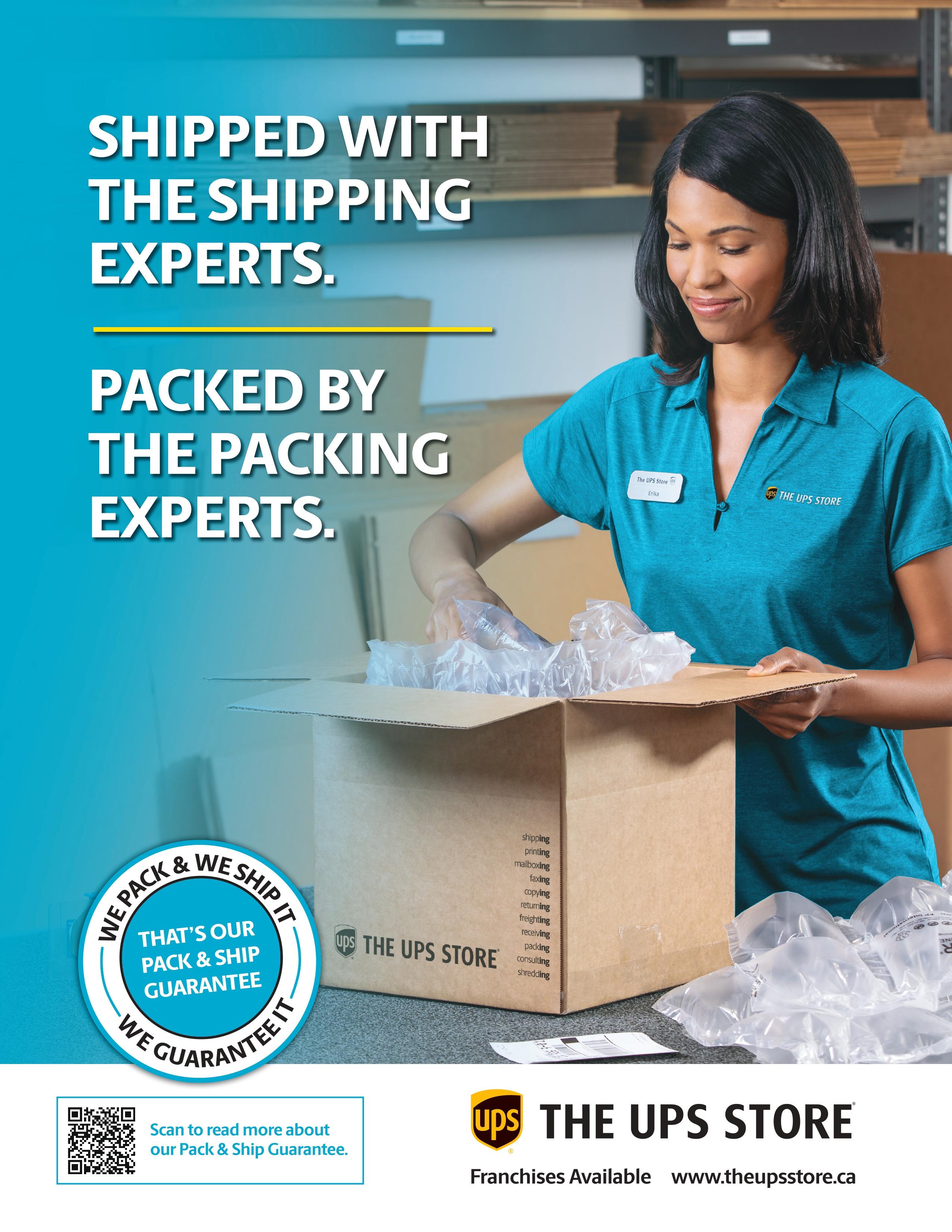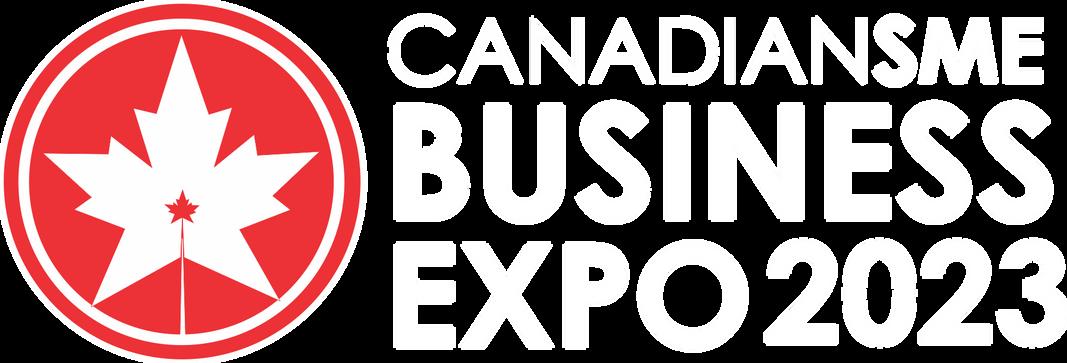






for a Thriving Small Business Community in Canada EXCLUSIVE Business Woman Of The Month CANADIANSME Empowering Canadian Small & Medium Businesses ISSUE NO. 54 PAGE: 30 MAY 2023 All Images, trademarks, service marks and logos referred to or appearing in this magazine arethepropertyof theirrespectiveowners. PAGE - 19 BankingPartner ShippingPartner Accounting SoftwarePartner Embracing Mental Health





Our May issue is officially here and we are very excited about all the great content we have included in this month’s issue! We strive to be Canada’s top magazine in providing exclusive insights, strategies, and advice to small business owners and entrepreneurs. Our mission is to include the best of the inclusive interviews and top business insights from reputable industry experts.

This month, CanadianSME is focused on retail and mental health awareness, we will feature top retail tech trends and articles featuring employer and employee well being This issue will also feature interviews and special advice from industry experts Read
“Revolutionizing Retail: The Top Trends and Tech for 2023” by Cubeler Business Hub. Check our Xero’s “Dear Advisor series; An accounting professional answers FAQs from Canadian small business owners”, “Level Up Your Cybersecurity with Penetration Testing” By Julius Azarcon, Vice President, Information Technology Services, CDW Canada. Learn more about “Why The Majority of Canadian SMEs Are Optimistic About Their Business Outlook Despite Economic Uncertainty Ahead”, By Chandrashekar LSP And read our exclusive interviews such as the one with Ashley Francisco, Head of Startup Ecosystem, North America, at Google, where we delved into Google for Startups Accelerator: Cloud program, its origins, and how it aligns with Google's mission to support startups and entrepreneurs; and with RBC’s Don Ludlow who joins us to share poll results and his insights on the impact of digital technologies on business today.
Leveraging Technology for SMB Growth! The CanadianSME Small Business Expo is coming on June 16th! The Small Business Expo 2023 emphasizes using technology to grow small businesses Technology has created many opportunities for entrepreneurs to gain a competitive edge, expand their markets, and adapt quickly to changing trends Attendees will learn to integrate digital solutions into their infrastructure and create innovative long-term business growth plans
Showcase your brand at CanadianSME Business Expo.



Are you a business owner who has a product or service and is looking to share it with the world? Are you seeking an opportunity to share your innovative business idea with thousands of small business owners and entrepreneurs? The CanadianSME Business Expo is the perfect opportunity to do just that!

The articles in this issue provide insights into the tools and resources available and 2023 retail trends to keep top of mind this year. We hope this month’s issue will help give you the knowledge and information you need to stay ahead in the market.
Don't forget to subscribe to our magazine to get the latest trends and stay current on all of our events.

Until next month, happy reading!

ISSN2562-0657(Online) PublishedbyCmarketingInc2800Skymark Avenue,Suite203Mississauga,ON Canada L4W5A6 ThecontentsinCanadianSMEMagazinearefor informationalpurposesonly NeitherCmarketing Inc,thepublishersnoranyofitspartners, employeesoraffiliatesacceptanyliability whatsoeverforanydirectorconsequentialloss arisingfromanyuseofitscontents Copyright©2022CMarketingInc Allrightsreserved Reproductioninwholeorpartofanytext, photographyorillustrationswithoutwrittenpermission fromthepublisherisprohibited All Images, trademarks, service marks and logos referred to or appearing in thismagazinearethe property of their respective owners. wwwcanadiansmeca info@canadiansmeca canadiansme canadian sme canadiansme canadiansme

Fraud Prevention: The Importance of Having a Plan in Place IN THIS ISSUE CanadianSME Small Business Magazine 32 It’s never been more difficult to run an SME But we ’ re working on that 49 Continuing Education units can be valuable partners in supporting employer-led upskilling and reskilling 60 16 Don Ludlow Vice President Small Business, BFS Strategy & Partnerships Royal Bank of Canada Guests on Earth: Transforming Home Care into Self-Care 64 RECOVERY FOR SMALL BUSINESS Strategy and Financial Models 71 Alberta is Helping to Fuel the Canadian Franchise Industry’s Continued Growth 45 Navigating Digital Transformation: A Guide for Canadian SMEs in Retail 43 The Digital Future of Canadian SMEs
By Paula Festas, CEO at Huumans



 By Chandrashekar LSP
By Chandrashekar LSP
Canadiansme Small Business Magazine 36 30 Business Woman Of The Month Shelagh Stoneham Why The Majority of Canadian SM Are Optimistic About Their Business Outlo Despite Economic Uncertainty Ahead
IN THIS ISSUE
What if we’ve got it all wrong? Equity, diversity, and inclusion (EDI) in the workplace 12





Canadiansme Small Business Magazine 38 26 40 Revolutionizing Retail: The Top Trends and Tech for 2023 23 Omni-Channel Strategies for Success with Zenergy Communications 34 Thinking of using ChatGPT in your business? Read this first Cameron Dallas on Mazlite's Impact in the Automotive Industry Crafting Authentic Social Impact: Insights from Prof. Jacob Brower
IN THIS ISSUE
Dr Kendra Vant, Executive General Manager of Data at Xero
Smallbusinessownersbelieve it’spossibletoprotectthe environmentandgrowthe economyatthesametime
Smallbusinessownershavealot weighingonthemrightnow,from pandemic-relateddebtand skyrocketingcoststodifficulty findingworkers,”saidJasmin Guenette,Vice-Presidentof NationalAffairsatCFIB “It’s importantthatpolicymakers considerthecurrentstateofsmall businessandhowenvironmental policiesandregulationswill impactsmallbusinessesandthe economyasawholeinthe monthsahead
PAYMENTS
TerraPaywelcomesVisaasa strategicinvestorandglobal partnerasdigitalcross-border tradeaccelerates TerraPayandVisa’scollaboration willpavethepathforholisticpay-in andpay-outsolutionsthatcan enhancetheusageofeligible commercialcardsforSMEs, extendingtoincludeaddedglobal money-movementcapabilities, includingcards,accounts,and wallets Atthesametime, merchantscanuseTerraPay’s Request-to-Paywalletsolution, globally



BestManagedCompanies Celebrates30Yearsof

Privately-OwnedBusiness ExcellenceinCanada
DeloitteCanadaisdelightedto announcethewinnersofthe2023 Canada’sBestManaged Companiesawards Celebrating thirtyyears,theprogramisthe nation’slongest-standinginitiative torecognizeleadingprivatelyownedCanadiancompanies
CMC-Canada’sManagementAdvisoryService(MAS)program celebrates20yearsofprovidingessentialsupporttoCanadian businesses
WOMEN'SEMPOWERMENT
TheCanadianAssociationofManagementConsultants(CMC-Canada)is proudtocelebratethe20thanniversaryofthelaunchofitsManagement AdvisoryServices(MAS)ProgramsupportingbusinessesacrossCanada
News
SMALLBUSINESS
SMALLBUSINESS
What if we ’ ve got it all wrong?
Equity, diversity and inclusion (EDI) in the workplace

Some of us have spent a huge part of our careers focused on how to bring justice into the workplace YWCA Canada has been on the receiving end of racism, sexism, homophobia and ableism at work, and as a National Office we committed ourselves to doing better in our practice As sector leaders we have fought for changes that we thought would lead to material change for those made to feel unsafe, unvalued, and invisible.
Trainings. Employee resource groups. Mentorship. Listening sessions.
We have done them all
And now
Now we are worried we have been going about this wrong all along
Recently, we got to hear the brilliant and powerful Sharon Nyangweso (she/her) founder of Quake Lab speak about where EDI measures in employment are falling short One of the main takeaways she left us with is the ineffectiveness of applying behavioral change approaches to systems level problems
Let us explain (also, go check her out for a deeper analysis) We have lots of evidence that Black, Indigenous and people of colour, people with disabilities, 2SLGBTQ+ people, women, newcomers, and youth face barriers to gainful employment, especially in leadership positions
The reasons for this are varied and complex, but all are informed by discriminatory and exclusionary workplace practices, embedded in hostile and harmful systems of oppression
Many workplaces have attempted to close these gaps through learning opportunities and policy changes intended to change how people interact at work Incorporating more inclusive language, instituting diversity-focused hiring initiatives, creating employee resource groups and mentorship programs – these are all examples of behaviorfocused change initiatives Entire industries have been built on these types of interventions
However, there is little evidence, or indeed research, on the effectiveness of these initiatives alone in reducing the barriers marginalized and underrepresented communities face at work
12- CanadianSME-May2023
Why? Because they don’t fully address the systems level barriers these groups face.
YWCA Canada’s Born to Be Bold research sought to identify the barriers marginalized women faced in accessing and retaining employment Almost all of the challenges participants shared were structural in nature – the need for more affordable housing and fair wages that cover basic necessities; skills and experience not being seen as sufficient or valid by employers, especially for newcomers and internationally-trained professionals; lack of accessible and affordable childcare and transportation; the need for workplace safety especially for survivors of trauma
These are systems level problems that cannot be solved through behavioral approaches
Training managers on how childcare responsibilities impact an employee’s performance may make them more open to offering flexible work accommodations to their team, but does it solve the larger problem? No That problem can only be fully solved by the creation of childcare spaces, or by employers providing financial support to help meet childcare costs.
Hosting a session on implicit-bias training may help team members be more careful in how they make decisions and use language in the workplace, but it alone will not solve the problems racialized employees and survivors of trauma face That requires a bigger investment in robust equity practices including affordable mental health supports and changes to employer benefits
Creating an employee resource group so under-represented team members can build community and have a safer space at work is one step in addressing feelings of invisibility and exclusion, but it needs to be matched by intentional hiring, performance management, advancement policies, and antidiscrimination practices that materially address workplace harassment
There is a place for all of the interventions mentioned above, but they are only part of creating meaningful change It is not an either or approach – it requires a “both/and” mindset As organizational leaders we need to go deeper We can’t do it alone – many of these changes require support from government and multi-sector partnerships as well – but we are an important stakeholder in this process. If we ’ re really committed to creating more inclusive and equitable workplaces, the time to be bold is now.
This means digging into the status quo to disrupt the way systems have been set up This means auditing organizational policies and their impact This means setting up wrap-around supports that address the multiple and compounding barriers that equity-deserving people face
YWCA Canada recognizes that this requires an all-of-society approach, with buy-in and active participation from those in leadership across sectors Our cross-sectoral economic empowerment initiatives bring employers, policymakers, service providers, academic partners and community members together to envision and co-create employment environments that speak to the distinct needs of women and gender diverse people This includes meaningful labour protections and employment standards, pay equity, action on workplace violence, and recruitment, retention, reskilling and advancement models grounded in a genderequity lens We invite you to join this bold movement for equitable employment futures
13- CanadianSME-May2023
By Julius Azarcon, Vice President, Information Technology Services, CDW Canada


With technology innovation happening at an accelerated pace and the sophistication of cyberattacks advancing just as quickly, small businesses need to remain vigilant and proactive with cybersecurity Cybercriminals are becoming more detailed and organized in their approach They now conduct in-depth research on businesses, studying their processes and identifying vulnerabilities that can be exploited
For small businesses, keeping up with the cyberthreats of today can be a drain of time and resources In fact, recent research from CDW Canada, a leading provider of technology solutions and services for Canadian organizations, found that one-in-four (25 per cent) small businesses have experienced a security breach in the past year One way businesses can keep pace and combat cyberthreats is by conducting penetration testing

14- CanadianSME-May2023
What Is Penetration Testing?
Penetration testing, also referred to as ethical hacking, is the performance of a controlled malicious attack on a business’ network to uncover any security vulnerabilities and evaluate the effectiveness of the system’s defence mechanisms The goal of penetration testing is to provide businesses with a comprehensive assessment of their security posture and to highlight areas where improvements can be made
CDW Canada recently commissioned its second annual penetration test survey to examine the sentiment of 500 Canadian IT professionals regarding the cybersecurity posture of their organizations and adoption of penetration testing
A comprehensive penetration test can reveal vulnerabilities and weaknesses within a business in the following areas:
Application servers
Operating systems
Websites
Mobile applications
IoT devices
People Operations
During a typical penetration test, a team of trained cybersecurity experts stage a controlled attack on a business’ security environment They use several tools and techniques to probe for weaknesses within those systems.
Why Are Small Businesses Hit the Hardest?
The recent survey revealed that the shift to hybrid and remote work has created new cybersecurity challenges for small businesses due to the use of personal devices and networks that may not have the same level of security as company-owned equipment Further, more than one third (36 per cent) of small businesses who have adopted remote/hybrid work since the pandemic believe it has increased their security risks
For example, the flexibility of working off your phone at a café may be convenient, but you ’ re using their unsecured network and providing easy entry points for cybercriminals to access your data So, how can penetration testing help small businesses improve their cybersecurity?
1. Identify vulnerabilities that cybercriminals could exploit to gain unauthorized access to their systems, steal sensitive data or disrupt their operations
2.Improve security measures such as implementing stronger passwords, updating software and updating network security.
3.Provide security assessments to identify cybersecurity risks and prioritize their efforts to improve their defences
By conducting penetration testing, small businesses can avoid financial losses, downtime and reputational damage caused by cybersecurity attacks In fact, more than two thirds (69 per cent) of small businesses who perform penetration testing reported that it has “somewhat to significantly improved” their overall security
Why Work with an External IT Partner?
Cyberthreats are only becoming more sophisticated and trying to fend them off alone may result in something being missed While it can seem like an overwhelming task, IT experts are here to help
Many small businesses already see the value in external help According to the survey, 64 per cent of small businesses have an external IT security services partner, a 49 per cent increase from the previous year
Working with a trusted IT partner can provide tremendous value, allowing small businesses to focus on what they do best while the experts focus on protecting them. Our survey revealed that more than half (59 per cent) of small businesses that have an external IT security service partner feel the value they provide has only increased in the last two years
Helping small businesses proactively address security risks and avoid potential data breaches that can be detrimental to their businesses, is just one of the ways CDW Canada provides value to small businesses To learn more about CDW’s cybersecurity services, please visit cdw ca/pentest
The Digital Future of Canadian SMEs
DonLudlow
Vice President Small Business, BFS Strategy & Partnerships Royal Bank of Canada

A recent RBC Small Business poll revealed that Canadian business owners and consumers alike say technology will continue to play a critical role in the future of small businesses In this interview, RBC’s Don Ludlow joins us to share poll results and his insights on the impact of digital technologies on business today
RBC's Don Ludlow discusses the impact of digital technologies on small businesses, highlighting the sustained growth in the digital economy and the importance of finding the right balance between digital and human experiences He emphasizes the need for businesses to adapt their strategies and operational practices to address new consumer demands Ludlow also shares insights on key indicators of business success and offers advice on how small business owners can invest in continued digital transformation and adoption to remain competitive in an ever-evolving landscape
Don is the Vice President Small Business, Business Financial Services Strategy and Partnerships at RBC He is responsible for leading RBC’s Small Business segment and teams In his role, Don provides strategic oversight in delivering market-leading client experiences through innovative partnerships and differentiated, beyondbanking solutions to help aspiring entrepreneurs and Canadian business owners start, manage and grow their ventures.
16- CanadianSME-May2023
The past few years since the pandemic have seen a rapid acceleration towards the adoption of digital technologies in the way we interact with businesses. Is there still appetite for digital experiences among Canadians, or do Canadians feel it’s reached an apex?
Our most recent RBC Small Business survey reveals that Canadians see sustained growth ahead in the digital economy and indicates their continued desire to engage with businesses online in new ways.
Less than half of Canadians (46 per cent) believe growth in ecommerce has peaked, signaling more opportunities to digitally engage with consumers However, a majority of small business owners (57 per cent) report that the ecommerce economy has reached an apex, highlighting a gap that business owners should look to bridge between their own beliefs and consumer expectations
Indeed, many Canadians foresee a future where e-commerce and technology remains firmly embedded in the way we live, shop, and do business Successful entrepreneurs will be those who adapt their business strategies and operational practices to address these new consumer demands
Though Canadians have indicated their continued appetite for e-commerce and digital experience, the findings reveal that human experiences are also important for the future of small businesses. Why is it important for small businesses to find the right balance between digital and human experiences?
When it comes to digital and human interactions, the poll indicates that the preferences of consumers aren’t ‘either/or’ –instead, they ‘want it all’ and choose depending on the context of how they interact with businesses and brands Accordingly, a balance between digital and human interactions will be important for the future of small business –especially when you account for the preferences of the younger generations
More than half of millennials (51 per cent) and two-thirds of Gen Z respondents (59 per cent) say they would prefer more digital interactions in the shopping experience. Similarly, six in ten Gen Z (66 per cent) and half of millennials (55 per cent) desire more digital interactions in their payments and checkout experiences.
Yet, when it comes to customer communications and marketing, eight in ten millennials (79 per cent) report that they would prefer more human touch – a sentiment shared by Gen Z (77 per cent) Three-quarters of Gen Z (74 per cent) would want more human touch to resolve customer issues and queries, with this number rising to 84 per cent among millennials

You’ve mentioned that technology now makes it easier than ever to start a business. But once you’ve started a business and gotten beyond day one, how do you know if your business is on the right track to survive and thrive in the long term?
While continuing to create digital touchpoints to deepen relationships with consumers is key to entrepreneurial success, small business owners polled say that the following are also important indicators of a thriving business on the path to sustained growth:
Digital Transformation
Establishing base of loyal repeat customers (63 per cent)

The ability to innovate and create new opportunities (51 per cent)
Having the funds to invest in growing and developing teams (48 per cent)
Hitting sales and/or new client acquisition growth targets for two consecutive quarters (47 per cent) Recording positive cash flow for two consecutive quarters (49 per cent)
The ability to successfully secure additional growth funding from external sources (42 per cent)
Digitize your supply chain. The goal of moving your supply chain to a digital environment is to minimize waste and increase productivity. To transform your existing supply chain process, investing in inventory management software can allow you to manage your inventory and check stock levels in real-time More complete systems will also send automatic low inventory notifications and generate purchase orders to replenish your stock
In addition, consider moving your supply chain to the cloud Cloud-based services can connect everyone in the supply chain, giving you visibility throughout every part of your network. Cloud-based supply chain management further allows you to respond to rapidly changing demands, monitor delivery networks and react to volatility before it becomes a problem
How should small business owners look to invest in continued digital transformation and adoption?
For small business owners, a steady approach to investment in digital transformation will allow them to sustain momentum in creating a digitally-enabled business model and meeting customer expectations over the long-term. Three suggestions for areas to invest in when digitally-enabling your business include:
Streamline your finances and accounting processes. While paper invoices and cheques are still used across businesses, the digital transformation of payments, deposits and accounting has become as easy as it is efficient, thanks to the multitude of solutions available
For example, you can request and receive payments from customers by using Interac e-Transfer With the Autodeposit feature, you instantly and securely receive funds without having to log on and answer a security question As well, adopting invoice and accounting software such as RBC's PayEdge can help to keep track of cash flow, forecasting and automate bill payments
Use data to support your decisionmaking. Once you have implemented digital processes across your business, you can use the data you have gathered to inform and support the decisions you make about the operation and growth of your business.
For this, online tools and platforms like RBC Insight EdgeTM for Small Business that provide real-time intelligence on client activity, preferences and spending patterns can be invaluable to dig deeper into your customers’ wants and needs, and to tailor your inventory accordingly
Realizing the full benefits of digital transformation isn’t immediate – instead, it requires steady investment and longterm commitment to this ongoing journey By rethinking how and where they do business and reinvesting in their own growth, Canadian businesses can tap into emerging technologies stay competitive in this environment
18- CanadianSME-May2023
Digital Transformation
EmbracingMentalHealth
As we approach Mental Health Awareness Month, it's important to address the topic that so often goes unnoticed in the world of small business Entrepreneurs and their teams have long been hailed as the backbone of the Canadian economy However, with mounting pressures and a constantly changing business landscape, the toll on mental health can be overwhelming This editorial will discuss why mental health should be at the forefront of small business concerns and explore ways to promote well-being in the workplace
Mental health is a critical component of overall well-being, yet it remains an often overlooked aspect in the small business world. According to the Canadian Mental Health Association, one in five Canadians experiences a mental health problem or illness in a year For small business owners and their employees, the impact of poor mental health can be substantial, affecting not just the individuals involved but the overall success and sustainability of the business
The pressures and uncertainties that come with running a small business can be immense, leading to higher levels of stress, anxiety, and depression Entrepreneurs often face long hours, financial insecurity, and the constant challenge of balancing work and personal life These factors can exacerbate mental health issues or create new ones, creating a potentially toxic work environment

19- CanadianSME-May2023
It's time for businesses in the Canadian ecosystem, regardless of size, to prioritize mental health and recognize its vital role in overall business success By fostering a healthy and supportive work environment, small businesses can not only improve employee well-being but also boost productivity, creativity, and morale
Here are some ways small businesses can support mental health in the workplace: Encourageopencommunication:
Create a culture of trust where employees feel comfortable discussing their mental health and any challenges they may face This includes fostering an environment where employees can ask for help without fear of judgment or repercussions

Offerflexibleworkarrangements:
Providing options for flexible work hours, remote work, or job sharing can help employees better manage their work-life balance and reduce stress
Providementalhealthresources:
Make resources available to employees, such as access to mental health professionals, workshops, or online tools Educate employees on the importance of mental health and how to recognize signs of burnout or other mental health issues
Promoteself-careandwellness:
Encourage employees to take breaks, eat well, exercise, and engage in activities that promote well-being Consider implementing wellness programs, meditation sessions, or offering gym memberships as part of your employee benefits package
Trainmanagerstorecognizesignsof
Equip your management team with the tools and knowledge to identify and address mental health concerns among their staff and support them in creating a supportive work environment
As we continue to raise awareness around mental health, it's crucial that small businesses in Canada play their part in fostering a supportive and healthy work environment By prioritizing mental health and taking the steps outlined above, small businesses can make a significant difference in the lives of their employees and contribute to the overall success of their organization When we commemorate Mental Health Awareness, let us take advantage of this chance to make mental health a top priority in the small business community
CanadianSME provides timely and relevant news and trends on Canada's small business ecosystem to support entrepreneurs in efficiently managing their businesses. Our magazine subscription offers novel viewpoints and valuable insights to help novice, and seasoned entrepreneurs overcome obstacles. By subscribing to CanadianSME's magazine at https://lnkd.in/dbqmSKN, you can stay ahead of the curve. For instantaneous updates, follow @canadian_sme on Twitter
mentalhealthissues: 20- CanadianSME-May2023
By Paula Festas, CEO at Huumans
A seasoned executive, Paula Festas brings over 25 years of experience and a proven track record of success driving global, high-performing organizations towards profitable partnerships

Currently CEO at huumans, a smart, cost-effective accountancy and bookkeeping service for small business owners, Paula uses her extensive skill set to support SMBs at every stage of their entrepreneurial journey
Cloudaccountingsoftwareappearstobeprettysimple togetthehangof,whydoIneedtoworkwithan accountantorbookkeeper?

The easy answer: if the term ‘month-end’ sends shivers up your spine, it’s probably time to hire a bookkeeper or an accountant to manage your books
One of the greatest technological advancements for small business owners is cloud accounting like Xero; these tools democratized the knowledge required to run a small business, and put the power back into the hands of so many business owners With that said, most people don’t get into entrepreneurship to spend their time reviewing financial statements Many people become entrepreneurs because they’re passionate about something and they want to make a living out of it; bookkeeping is just a necessary part of running a business that many people will choose to outsource if they have the option
Accountants and bookkeepers aren’t much different than any other professional service you would hire, like a hairdresser, a contractor, or real estate agent. You hire these people because they’ve spent time honing their craft, and you can trust them to do a good job. In a world where some small business owners will hire their cousin’s friend’s uncle to do their bookkeeping (nothing against them—we’re sure they’re very nice!) there is undeniable value in hiring a trusted advisor to ensure your books are organized, up-to-date, and not sounding any alarms.

Ofcourse,thedecisiontobringonanaccountant orbookkeeperdependsonalotofvariables. Beforeyoumakethedecision,askyourself:
Is your business full-time, part-time, or a side hustle? If you’re earning under a certain threshold per year, or you’re simply reporting on revenue and expenses, you might be able to get away with using a cloud accounting software. If all your income is coming from your small business it might be worth having a professional take the helm
Would you consider yourself a numbers person? I don’t think you need a finance degree to manage your bookkeeping, but it does help to be comfortable with financial statements, especially when you need deeper insight into your business’ performance Having difficulty keeping track of bills, invoices, and receipts? You might want to hire a professional
Do you have employees or hire contractors? If you’re responsible for deducting tax from employees, managing payroll, and distributing tax forms, you’re probably in a situation where you need to outsource your bookkeeping.
If you consider yourself a little tech savvy and your business’ finances are relatively straight forward, you could get away with managing your books using a cloud accounting software like Xero, but if you have plans to scale your business or bring on employees, it’s advisable to bring on a professional to make sure you ’ re covering all your bases Especially if you ’ re in a position where you need to make quick business decisions, it can be valuable to bring on a bookkeeper to reconcile your books bi-weekly or even weekly.
If your needs are a bit more complex, bringing on an accountant might be the best approach An accountant can prepare P&L statements, tax returns, cash flow projections, business forecasts, as well as provide advisory services for small business owners who are facing anything from applying for a loan, to having conversations about buying or selling a business On top of that, if you have (or plan to hire) employees, an accountant can get your business set up so you ’ re paying the correct provincial and federal taxes, insurance, and other deductions, so once tax time rolls around you dont have any surprises
As CEO of huumans, we ’ re helping break down the barriers small business owners face when applying for loans or credit products We’ve seen it first hand: banks can view small business owners and entrepreneurs as “high-risk”, but with an accountant to prepare the financial statements you need, the credit application process becomes more straightforward We provide clients with an AI-powered small business reporting dashboard that provides real-time and predictive insights about small business health Through a simple integration with cloud accounting software, the dashboard provides calculations for everything a business owner or advisor needs from COGS to payroll
So, to go back to the initial question, cloud accounting platforms are great and many entrepreneurs can and do manage their own bookkeeping with ease, but there will always be people who either dont feel comfortable with this technology, don’t have time to take care of the day-to-day operations, or simply want a professional opinion or an advisor to help them in their small business journey, and huumans is here to support those people every step of the way
Disclaimer: This material has been prepared for informational purposes only, and is not intended to provide, and should not be relied on for, tax, legal or accounting advice
22- CanadianSME-May2023 Accounting
evolutionizing Retail: The Top Trends and Tech for 2023 R
Cutting-edge technology is revolutionizing the way the Canadian retail industry does business Now more than ever, it’s essential for small and medium-sized retailers to keep up with the latest trends and embrace new technology or risk getting left behind

The world of retail has barely had time to catch its breath since the Covid-19 pandemic sped up the adoption of digital technology by almost a decade in a matter of months, ushering in everything from hybrid and omnichannel customer journeys to improved online retail experiences and payment methods.
This year, the retail sector is expected to see even more significant changes with the emergence of new technology-driven trends capable of revolutionizing the way customers actually shop. What does this mean for small and medium-sized retailers in Canada? Their answer could mean the difference between surviving and thriving in 2023 and beyond!
23- CanadianSME-May2023
In our digital-first world, keeping up with the latest technology trends is more critical than ever for SMEs that want to stay economically viable The future, after all, now belongs to businesses that can anticipate the needs and demands of their customers, improve their shopping experience and increase revenue every step of the way Who doesn't want that?
So, what are the top tech trends that Canadian retailers simply can’t ignore? Here's a quick rundown of the four major trends changing the face of retail in 2023 and beyond:
1. Living the metaverse, VR and AR shopping experience
Have you ever wished you could try on clothes or see how furniture looks in your home before making a purchase? With the metaverse, virtual reality (VR) and augmented reality (AR), you can

The metaverse, a virtual shared space, coupled with virtual reality and augmented reality, is set to take the retail industry to the next level, providing customers with immersive shopping experiences.
High-end brands like Versace, Armani and Sephora are launching their stores in the metaverse, allowing shoppers to virtually try on clothes, makeup and perfume before making a purchase IKEA’s AR app will even enable shoppers to preview furniture in their homes before purchasing
2. Decoding data with AI and machine learning
Artificial intelligence and machine learning are changing the online retailing game, providing valuable insights into customer behaviour and preferences
But that's not all this technology can do Artificial intelligence (AI) and machine learning can also help retailers optimize inventory management, improve customer service and create personalized experiences With computer vision technology, retailers can even identify products on shelves, monitor inventory levels and analyze customer behaviour
The Cubeler Business Hub™, a nocost, membership-based platform, uses AI-powered business financing, advertising, networking and business intelligence tools to help small and medium-sized retailers and SMEs in other industries unlock the full potential of their business
3. Reinventing the shopping journey via omnichannel retailing
Gone are the days of a simple brick-and-mortar store! Smart omnichannel retailing aims to provide a seamless shopping experience for consumers across all channels, including e-commerce websites, mobile devices, and even physical stores
This approach offers retailers the ability to interact with their customers, regardless of their location From curbside pickup to
24- CanadianSME-May2023 Artificial Intelligence
same-day delivery and "buy online, pick up instore" (BOPIS), the possibilities are endless
For Lululemon, making it easy for customers to pick up their orders with fast and convenient curbside pickups has been a boon for business Today, 20% of its customers who choose to pick up their orders in-store make an additional purchase, boosting the brand’s in-store sales
And this is just the beginning of the omnichannel story In the future, retailers, big and small, will continue to create new and improved hybrid and omnichannel customer journeys that are even faster and more hassle-free
4. Greening the retail industry for a more sustainable future
Yes, advances in technology have made our lives easier On the flip side, though, cutting-edge tech has also heavily impacted the environment with increased carbon emissions, leaving an everlarger footprint
Sustainability, as a result, is a huge and growing concern. In response, retailers are rising to the occasion, incorporating environment-conscious and eco-friendly practices into their business models
And just in time This trend is not only essential for the future of the retail sector it is gaining momentum with consumers who want retailers to take even greater responsibility for their impact on the environment
From autonomous delivery vehicles to sustainable packaging options, retailers are answering the call, building brand loyalty, attracting environmentally conscious customers and reducing their carbon footprint
According to a Retail Week report, “ many retailers and brands are making efforts to be greener, and this is capturing customer attention Consumers named their top five most sustainable companies in the industry as H&M, Nike, Primark, M&S and Amazon.”
By embracing the top tech-driven retail trends of 2023, Canadian retailers can bring the customer experience to new heights, advance their operational efficiency and unlock new growth opportunities But there are a few things to keep in mind before you take that leap of faith especially if youre a small or mediumsized retailer
First and foremost, it’s essential to determine if these trends align with your business goals, target audience and overall strategy Just because a trend is popular doesn't necessarily mean it's the right fit for your business
Secondly, it’s important to approach new technology with caution it can be costly and time-consuming to implement Before making any investment, be sure to conduct thorough research, pilot tests and cost-benefit analyses
Lastly, don’t forget that while technology is playing an increasingly important role in shaping the industry's future and the shopping experience, it cannot replace the importance of human interaction and personalized customer service
Even with the latest technology at your fingertips, building relationships with your customers and providing them with top-notch service should always come before stay ahead of the curve via the latest trends and tech advances
With careful consideration, a well-built strategy and a willingness to adapt, you’ll be ready to take those first small steps toward the future of retail innovation, create an exceptional shopping experience for your customers and drive your business growth
Artificial Intelligence
Taking some small steps today could make you the next big thing in retail tomorrow
In an interview with Cameron Dallas, Chief Technology Officer at Mazlite, he discusses the deep-tech startup's focus on improving industrial sprays and coatings, particularly in the automotive industry. Mazlite's platform utilizes AI, computer vision, and other cutting-edge technologies to solve complex technical problems. Their advanced spray monitoring platform for the automotive industry detects potential defects before a part is coated, allowing plant operators to make adjustments and improve quality control. Despite challenges in implementing the technology, pilot projects with automotive manufacturers have been successful Mazlite plans to expand its technology to various industries, including pharmaceutical manufacturing, agriculture, and aerospace Dallas highlights the importance of automation, technology, and partnerships in driving innovation and reducing environmental impact in the automotive industry
Cameron is Chief Technology Officer at Mazlite, an advanced manufacturing startup. With a degree in physics from the University of Victoria and a Master's in aerodynamics and high-performance computing from the University of Toronto, he co-founded Mazlite from a research project he volunteered for while completing his Master's degree.

Can you tell us a bit about Mazlite and your role as the Chief Technology Officer?

Mazlite is a deep-tech startup that focuses on improving industrial sprays and coatings across a wide variety of industries Currently, our main focus is on automotive painting, but there are other opportunities in pharmaceutical production, agriculture, battery production, and many more sectors I didn’t know anything about sprays before getting involved in this research, but now I see sprays all over the place Almost everything gets coated, from cars to batteries to kitchen equipment – it’s everywhere!
The Mazlite platform we have built relies on innovation from multiple different fields including AI, computer vision, fluid mechanics, optics, and mechanical/software/electrical engineering My role is to understand the complex technical problems our customers face, and then organize and guide our teams to create a product that solves these problems For me, it's a fun combination of learning about a variety of cool, cutting-edge technologies, and also working collaboratively with people to build new things
What inspired Mazlite to develop an advanced spray monitoring platform for the automotive industry?
We were involved in spray-related research at the University of Toronto and we kept having large companies come to our lab looking for answers to their spray and coating problems All the companies seemed to have the same type of problem, so we started working on a product that could address their issues. Then, we started going out to these companies, giving presentations, doing demos and getting their feedback We gained great insight into the issues these companies experience, and we began to understand that there is a huge market here that no one really knows about
 Chief Technology Officer at Mazlite
Chief Technology Officer at Mazlite
Can you explain how your technology works and how it helps improve the automotive spraying process?
Sprays are extremely sensitive and many things can cause defects to occur For example, a change in humidity or temperature throughout the day can cause a nozzle to produce a defective part The only quality control manufacturers have currently is to inspect the part after it has been coated and scrap it or rework it if the part does not meet their standards The Mazlite platform is an imaging system that takes high-resolution pictures of the spray before a part is coated Then, we developed analytics using AI and our deep scientific understanding of sprays to determine if the spray will produce a defect or not If our system identifies a possible defect, we let the plant operators know and they can make adjustments to the nozzle to ensure the part does not come out defective
How has the automotive industry responded to Mazlite's technology? Have you faced any challenges or resistance in implementing your solution?
There is a huge amount of excitement over this technology
Everyone in the paintshop knows they face significant challenges every day and new technology to help make their life easier is exciting However, I cannot understate how technically challenging this problem is The paintshop has the most strict safety requirements as it is an explosive environment, which is difficult to design for We have to integrate our technology with advanced paint robots, IoT devices, and a variety of other standard processes
The automotive market is extremely competitive, which makes it more resistant to adopting new technology to an already complicated process if companies don’t absolutely know it’s going to work Finally, the paintshop is usually understaffed, so finding people who have the time to consider new technology can be difficult
To address these challenges, we have a variety of pilot projects with automotive manufacturers to prove our technology and those continue to be a great success
Are there any plans to expand your technology to other industries or sectors beyond automotive manufacturing?
Definitely! As I said before, sprays are everywhere There are big opportunities in pharmaceutical manufacturing with spray drying, thermal coatings on electric car batteries, agriculture for optimizing watering and fertilizer spraying, aerospace for painting and fuel injector quality control, food manufacturing for making powders like sugar, coffee, and milk, and many more
Lastly, can you talk about the importance of automation and technology in driving innovation and progress in the automotive industry?
Automation and technology are hugely important for driving progress in many parts of the automotive industry These are complex problems, and to innovate, we need to source ideas and talent from a variety of different places We’ve been very lucky to partner with organizations like Mitacs and universities like UofT that make it possible for us to work with talented researchers who can really help us make progress on these challenges. With Mitacs’ support, for example, we brought on an intern – a UofT Post Doc with specialized knowledge of automotive paints – to work on innovation challenges related to commercialization This internship has been extremely helpful in innovating and speeding up the commercialization process
Another area that I’d like to highlight is making progress on climate change There is a lot of waste and emissions that come from making cars, particularly from the paintshop Painting uses the most energy of any step in making a car, and it produces the most greenhouse gasses of any step in the process Automated sensors and IoT devices are critical for giving plant operators the tools and data they need to reduce waste and improve the plant's environmental footprint
Industrial Spray Monitoring Solution
Small and medium-sized enterprises (SMEs) form the backbone of the Canadian economy, and we recognize the pivotal role they play in driving growth and employment As a small business magazine, we appreciate the difficulties that SMEs encounter on a day-to-day basis and the opportunities that they have to innovate and succeed We firmly believe that a key factor in achieving success is nurturing the wellness of employers and employees alike A healthy and motivated workforce is more productive and committed, which in turn leads to better outcomes for the business
Therefore, we aim to provide our readers with practical advice and insights on how to prioritize well-being in the workplace and to highlight examples of businesses that have successfully implemented such strategies
This article will explore the importance of fostering a healthy work environment for Canadian SMEs and offer practical strategies to promote the well-being of everyone involved

FosteringaCultureofWell-being:
The well-being of both employers and employees is crucial not only for personal satisfaction but also for the long-term success of a business A healthy and supportive work environment increases productivity, lower turnover rates, and overall business growth. In SMEs, where resources may be limited, investing in the well-being of the workforce can yield significant returns

28- CanadianSME-May2023
OpenCommunication:
Establishing open lines of communication within an organization allows employers and employees to voice their concerns and needs Encourage regular check-ins, and promote a culture of trust where everyone feels comfortable discussing their prosperity This not only strengthens the relationships within the team but also helps identify any potential issues before they escalate
Flexibility:
One of the advantages of SMEs is their ability to adapt to change quickly Implementing flexible work policies can help employees strike a better work-life balance, resulting in increased job satisfaction and reduced stress Consider offering remote work options or flexible hours, giving employees the freedom to manage their time effectively
EncourageContinuousLearning:
Professional growth and development are essential to employee welfare SMEs can provide training and development opportunities for their staff, empowering them with new skills and knowledge This benefits not only the employees but also the company as they become more valuable and efficient in their roles
PromotePhysicalandMentalHealth:
Investing in the physical and mental health of employees is crucial for their overall success Encourage regular exercise, promote healthy eating habits, and provide resources to help manage stress Organize team-building activities or create dedicated spaces for relaxation and mindfulness.
RecognizeandRewardAchievements:
Acknowledging and rewarding hard work and dedication can significantly impact employee satisfaction and motivation Establish a recognition program that highlights individual and team accomplishments, and make a point to celebrate milestones together as a company

All in all, prioritizing the welfare of both employers and employees is paramount for the growth and success of Canadian SMEs By fostering a culture of open communication, flexibility, continuous learning, and promoting physical and mental health, businesses can create an environment that thrives Navigating through an everchanging business landscape, it is essential to invest in the prosperity of our workforce – the driving force behind any successful company. Let us strive to build stronger, healthier, and more resilient SMEs across Canada
CanadianSME provides timely and relevant news and trends on Canada's small business ecosystem to support entrepreneurs in efficiently managing their businesses Our magazine subscription offers novel viewpoints and valuable insights to help novice, and seasoned entrepreneurs overcome obstacles By subscribing to CanadianSME's magazine at https://lnkd.in/dbqmSKN, you can stay ahead of the curve For instantaneous updates, follow @canadian_sme on Twitter
29- CanadianSME-May2023 Canadian SMEs
BusinessWomanOfTheMonth
FounderofPowerWearHouseInc
AGameChangerintheWorld ofFitnessWearables
Sometimes the stories of success that seem small, often end up having a huge positive impact And that’s exactly what we ’ re about to elaborate on in this editorial piece Shelagh Stoneham is a Canadian businesswoman and the founder of Power Wearhouse, who has made a significant impact in the field of sports wearables. Her innovative approach to design and manufacturing has led to the creation of a unique fitness accessory that has gained popularity in North America
As a true business leader and entrepreneur, Stoneham has shown that a successful business can be built around addressing the specific needs of a neglected market segment She has earned the recognition of CanadianSME's May 2023 Business Woman of the Month for her dedication to excellence in product quality, customer service, and aesthetics


VisionandCreativity
Power WearHouse's Weighted Fitness Vest was first launched in 2021 as a response to market demand for an age-appropriate, commercially accessible weighted vest Improvements such as stacking weight systems, a thinner vest profile, and configurable interlocking weights in 8oz increments are just some of the ways in which customer input has informed design concepts since the product's first release (up to 20lb)
30- CanadianSME-May2023
Comfortable,Elegant,andSturdy
Shelagh and her team take great delight in designing and manufacturing premium workout apparel with an emphasis on comfort, style, and quality for physically active adults The Power Wearhouse Weighted Fitness Vest is a sleek and comfortable weighted vest that can be worn at home and for an extended period of time, unlike other weighted vests that are designed for sports The vest's two-way, easy-pull zippers also make it convenient for the elderly to put on and take off
FuturePlansandCurrentChallenges
Looking ahead, Shelagh Stoneham has ambitious plans for Power WearHouse Inc She aims to make their Power Weighted Fitness Belt and Vest a common fitness accessory for those aged 50 and over to promote better cardiovascular health, muscle strength, and bone density.
Although, like many businesses, Power WearHouse Inc faced a significant hurdle due to the COVID-19 pandemic The rotating closures of overseas manufacturing plants led to delays in sourcing multiple manufacturers, making it challenging for the company to deliver products on time Despite this setback, Stoneham remains committed to delivering quality fitness wearables and continuously seeks to improve and overcome challenges
TheActofGivingBack
When she is not creating fitness wearables, Shelagh is usually busy giving back to her community. She has established a philanthropic arm of Power WearHouse Inc, which focuses on donating a portion of the companys profits to organizations that support the health and wellbeing of older adults Her faith in the importance of social responsibility has led her to create partnerships with local senior centers, where she provides free fitness classes to help seniors stay active and healthy
Her dedication to social responsibility is not only admirable but also helps to create a positive impact on the wider community Her commitment to promoting health and wellness among older adults is a testament to her belief in the importance of living an active and fulfilling life, even in our later years
As Power WearHouse Inc continues to grow and expand its reach, it is clear that Shelagh's vision for the company extends beyond just creating innovative fitness wearables. It is also to make a meaningful impact in the lives of older adults. The company will undoubtedly play a pivotal role in the future of fitness wearables, leading the way in this dynamic field by offering fashionable and functional items that support wellness and fitness
If the fitness enthusiast in you is also looking for age-appropriate and very effective exercise wearables, then visit https://powerwearhouse.com/products/.

CanadianSME provides timely and relevant news and trends on Canada's small business ecosystem to support entrepreneurs in efficiently managing their businesses Our magazine subscription offers valuable insights to help entrepreneurs overcome obstacles By subscribing to CanadianSME's magazine at https://lnkd.in/dbqmSKN, you can stay ahead of the curve. For more real-time updates, follow @canadian_sme on Twitter.

31- CanadianSME-May2023 Women Entrepreneurship
Fraud Prevention: The Importance of Having a Plan in Place

In recent years, cybersecurity has become a major topic of discussion, especially with technological advancements and businesses shifting to digital models Although generally beneficial, these rapid advancements have also left room for security breaches, making it necessary for businesses of any size to have a plan of action in place to defend themselves against cyber-attacks Fraud prevention is a crucial part of protecting your business and customers from the damaging effects of cyber-attacks.
Fraud refers to intentional deception for personal or financial gain, while cyber-attacks are malicious activities that target computer systems or networks Common types of cyber-attacks include malware, phishing, and ransomware In any case, fraud and cyber-attacks usually lead to financial losses, data breaches, and reputational damage, which can be costly for businesses to recover from Establishing a clear line of defense to prevent fraud and protect against potential attacks is essential For small to mid-size businesses the first line of defense is employees, with the right training and knowledge they can help withstand cyber-attacks when they occur Prevention measures help reduce the risks of cyber-attacks and protect businesses from financial and reputational damage Failure to protect customer data can lead to legal repercussions and lost revenue
Path to Prevention
A well-designed fraud prevention plan should be regularly updated to keep up with the latest threats Employees should be trained to identify potential threats, understand best practices when dealing with threats and most importantly, know where to turn if a potential threat is spotted (phishing emails or system glitches)
Artificial intelligence (AI) has been proven to be a powerful tool of defense against cyber-attacks although it is sometimes costly Businesses can utilize AI to identify and detect patterns in malicious software or can be used to analyze financial transactions to identify patterns of fraudulent activity AI technology can shift through vast amounts of data in a short time and identify patterns humans may miss, helping to detect and prevent fraud more quickly and accurately AI, like all technology, can be used for good and bad and recently has become a powerful tool for cyber-attacks, helping fraudsters through deepfakes or AI-powered phishing scams However, even with the best technology, the human element of the defense plan remains the most powerful tool In fact, the way businesses (big and small) respond to cyber-attacks goes beyond repairing systems and requires all hands-on deck to respond to the damage and protect the businesses future
It is about ensuring that appropriate communication is relayed to business leaders, employees, and stakeholders, “As technology advances, and AI continues to improve and become readily accessible, it is imperative to ensure employees are trained to identify and assess fraud Safeguarding your business data is extremely important Businesses should assume they will face a cyber threat and have a plan of action” says Shawn McGuire, Chief Technology Officer for Resiliency of Kyndryl A prevention plan should always be communicated to employees, customers, and partners to ensure everyone understands their role It should include guidelines on how to detect and report suspicious activities and respond to security incidents
Implementing Prevention Tactics
Small to mid-size businesses should implement training programs that cover best practices for information security, such as password hygiene, safe browsing, and identifying phishing scams Training programs can be delivered in a variety of formats, including online courses, in-person training sessions, and awareness campaigns Some measures that can help prevent fraud and cyber-attacks include:
Conducting a risk assessment: Start by identifying the specific types of fraud and cyber threats that the business may face. This can be an evaluation of your systems, processes, employees and roles or responsibilities.
·Implementing safeguards: Once you have identified potential risks, take steps to implement safeguards that can mitigate these risks This can include measures such as firewalls, antivirus software, encryption, multi-factor authentication and data protection strategies
·Training employees: It can’t be said enough, employees are often the first line of defense against fraud and cyberattacks Employees should be trained on best practices for information security, such as setting up strong passwords, identifying phishing scams and avoiding public Wi-Fi networks when using their work laptops or smartphones
Exercise and testing: conduct regular penetration testing and exercises to establish understanding of areas of weakness within technology configurations, detection, response and recovery processes.
Monitoring and updating: Fraud and cyber threats are constantly evolving, so it's important to regularly monitor your systems and update your safeguards and training programs to stay ahead of the latest threats.
Finally, trust within a business is extremely important, especially with rapid advancement of technology However, it must be earned by establishing beneficial tools and resources like the ones outlined above, ones that should be implemented for all within a business, big or small. Giving your employees access to this kind of information and training facilitates a better understanding of what to look out for within a social network, email thread, and even text messages Deciding on when to implement prevention tactics differs between businesses, the sooner you can establish a plan, the better, and easier it will be to spot digital threats to your business
Looking to the future
Fraud and cyber-attacks are serious threats that have severe consequences for businesses By taking a proactive approach and implementing a plan that includes risk assessments, safeguards, employee training, and ongoing monitoring, businesses can reduce their risk of falling victim to fraud and cyber-attacks As a business continues to grow, learning how to navigate types of fraud like phishing, data theft, and bribery requires an ongoing and active effort In our fast-moving world and continuously evolving digital landscape, it is crucial for businesses to think about, implement and communicate prevention plans against cyberattacks to concerned parties It’s not just an issue concerning the IT department, but one that should involve employees at every level of your small to mid-size business
Cybersecurity
In our recent conversation with Jacob Brower, an associate professor of marketing at Smith School of Business, he offered valuable insights on a commissioned survey and discussed strategies for businesses to ensure their social impact initiatives are seen as authentic, rather than merely capitalizing on trends or bolstering public image.

Dr Jacob Brower is an associate professor of marketing at Smith School of Business and a recognized expert on corporate social responsibility (CSR) His research areas include corporate reputation and brand management, CSR, brand activism, and sustainability Brower’s work examines the factors that drive corporate social performance (CSP) by firms, and how a firm’s history of CSP impacts the payoffs from changes in its current CSP level Prior to earning his PhD, he worked as a consultant and market research analyst specializing in brand management and tracking for several Fortune 500 clients including FedEx, AT&T and IBM.

You’ve made corporate social responsibility (CSR) a main focus of your research at Smith School of Business What drew you to this particular area?

Back in high school, I was interested in the interface between businesses and the environment and in the ways that businesses could improve their impacts on the environment When I started my undergraduate education, I intended to study environmental engineering, as I thought that would land me at the intersection of technology, business, and the environment I quickly learned two things: that’s not what environmental engineering is about and I’m not an engineer
I went on to pursue an Environmental Economics PhD, but that still felt too restrictive for the kinds of questions I wanted to focus on It wasn’t until I ultimately wound up working in marketing that I was finally able to bring together my driving passions in marketing strategy and business adoption of environmental, social and governance (ESG) practices It was a bit of a circuitous route, but ultimately brought me to a career I really enjoy and one that makes me want to get out of bed in the morning
A survey commissioned by Smith School of Business reveals that Canadians believe businesses should dedicate 21% of their profits to solving important social issues. How can businesses balance social impact and profit?
I think one of the biggest challenges is to move away from looking at these two domains as being opposed Evidence suggests that the two are intimately linked On one hand, there are businesses that are using ESG and social impact to try to stand out from the crowd and drive positive responses from a variety of critical stakeholder groups On the other hand, a business that fails to have its house in order is more likely to be punished when it makes mistakes, while those that have a stronger social record experience an insurance effect that can protect them from such punishment Further, businesses are increasingly finding that access to capital is becoming more challenging if they haven’t considered these issues, so failing to focus on social impact can not only make operating in today’s world riskier, but also more expensive
34- CanadianSME-May2023
Associate Professor of Marketing at Smith School of Business
That said, businesses need to make sure they understand what their key stakeholders value and what will motivate them to continue to choose one business over another when they make decisions about where to shop, where to work, which partners to work with, etc It’s very easy to get lost in the myriad demands that exist out there, but the best place to start is to understand those core stakeholders, what their expectations are, and to ensure you ’ ve got our house in order with respect to those issues. While my research suggests that this approach may not drive huge responses in terms of the top line, it does help us to make sure we are managing the risk-side of the equation to ensure stability in the face of rapidly changing market expectations
When should business leaders speak out on social issues and why should they do so? How can businesses ensure their social impact initiatives are perceived as genuine and not just an attempt to capitalize on popular trends or improve their public image?
These are some of the biggest questions that we face now in the social impact space Increasingly, businesses are being pushed to go beyond ‘cleaning house’ and being pushed to take a stand on some of the most pressing issues facing the world This really goes back to the response above Before a business decides to jump into the social activism space, they need to make sure they’ve got their ducks in a row There are three big questions to consider before getting involved
First, before a business decides to take a stand on a critical social issue, it’s important to make sure their house is in order For example, when Starbucks launched the maligned #racetogether campaign, it immediately faced criticism for its record on hiring, retaining, and promoting people of color in the upper levels of the organization, as well as for its treatment of frontline employees who were tasked with implementing the new program If an organization is going to jump into the discussion, they’d better understand that their record is going to be brought into the conversation Are they ready for that, and what are stakeholders going to say?
Second, understand where an organization’s key stakeholders stand on a particular issue These social activism stances are divisive by nature, and the ultimate market response is going to depend on the concentration of stakeholder’s sentiments on either side of a particular issue In some cases, a business’s customer base, for example, may be unified in their perspectives, and even though there may be detractors out there, if they’re not connected to your business then the overall impact is likely to be at least
minimally negative, and perhaps even drive a positive response from those who feel strongly about the issue On the other hand, if the customer base is more evenly split, then the hardships that can be created by taking a stance can be much more significant We saw this with Nike when they launched their Dream Crazy campaign featuring Colin Kaepernick. While there was an initial backlash from detractors, most of the people who were upset about Nike’s stance weren’t engaging with Nike in the first place, and it resulted in a significant boost to Nike customer preference and financial performance, despite the initial negative response from some disconnected groups
Third, how likely is the business going to be able to drive meaningful change through the actions that they’re putting in place? If the first two questions above have been thoughtfully considered, it’s also important to consider whether (and how) we can do something meaningful to move the needle on a social issue A great example of this was when Ben and Jerry’s launched their Dismantle White Supremacy campaign It took a very thoughtful approach to both show how the organization could make the situation better, but also build strong relationships with stakeholders like the National Association for the Advancement of Colored People (NAACP) and Color of Change This allowed Ben and Jerry’s to learn from these organizations and how they could best partner to help fight the entrenched systems of racism that exist in society at the highest levels What this suggests is that if you ’ re going to take a stand, it needs to be a real stand If it’s a surface level commitment, those stakeholders who care about these issues are going to notice, perceived authenticity will be lost, and you might get slammed from both sides: both by those who oppose the stance and by those who care about the stance but feel that the company is just trying to cash in rather than truly be part of the solution
To read the full report from Smith School of Business on the role of business leaders in tackling social issues, view interview clips with leaders, and access a discussion guide for leadership teams visit wwwsmithqueenscom/now Business School
WhyTheMajorityofCanadianSMEs
AreOptimisticAboutTheirBusinessOutlookDespiteEconomic UncertaintyAhead
With the pandemic waning, new challenges are on the horizon - including inflation, supply chain issues, geo-political conflict, and potential economic downturns to name a few. Despite all this uncertainty, the recent Zoho Canada SMB Outlook Report points to overall optimism amongst business leaders across the country

 By Chandrashekar LSP
By Chandrashekar LSP
According to the survey ’ s findings, Canadian small and medium-sized enterprise leaders are optimistic about their business prospects, with 62 1% of respondents expecting to grow between 1% and 20+% during the upcoming months The bi-annual report surveyed 1,016 business leaders (C-level to manager) in Alberta, British Columbia, Ontario and Quebec in March about business performance, staffing, the economy, and tech usage
36- CanadianSME-May2023
The fact that SME leaders are successfully navigating today’s economic, staffing, cybersecurity, and customer privacy challenges while still remaining highly optimistic about business growth and profitability, suggests that Canada could fare well during a possible upcoming recession
KeyReportFindings
The key report findings paints an overall picture of optimism amongst the Canadian SME community, with Ontario respondents feeling particularly good and 63 8% expecting to grow between 1-20+%
In terms of optimism about business growth across the country, 53% of surveyed businesses in Alberta expect to grow between 1-20+%, in British Columbia 65% expect to grow between this same amount, and 59 7% of Quebec SMBs expect similar growth
SMEStaffingHoldingSteady
Additionally, businesses across the country are holding steady with staffing based on 70 1% indicating no change in their hiring plans, 25 8% hiring, and only 4 1% anticipating layoffs And, just over 10% of respondents said that inflation has impacted hiring, with the recent increase in business costs being nearly twice the challenge as that of interest rates
WhytheSMEOptimism?
So, why are Canadian SMEs generally optimistic about their business outlook despite potential upcoming challenges? Zoho customer MariaCecilia Arango, administrative assistant at Richporter Lighting, says, “Even if the economic context presents challenges for companies today, as technology continues to evolve, it becomes more accessible I am optimistic about the growing number of users who will be empowered to shape a brighter future this year and beyond "
TechnologyPriorities
With this viewpoint in mind, I believe that Canadian SMEs continue to be agile and are optimizing their technology usage to address potential challenges, making them more resilient - and optimisticabout their business outlooks and the future Indeed, across the surveyed respondents, technology use was prioritized on areas such as customer experience and improving decisionmaking processes - areas which can help SMEs weather economic storms
Customer experience was the top priority for tech usage across all provinces, with 40.3% in Alberta focusing on customer experience via their tech, 36.8% in BC, 45% in Ontario and 34.7% in Quebec.
Additionally, staff optimization was reported to be the next most important tech priority with 21 1% of respondents indicating that tech facilitates remote work and 20 5% investing in talent and digital skills
InConclusion
The data findings in the Zoho Canada SMB Outlook Report are encouraging based on business leaders successfully navigating today’s economic, staffing, cybersecurity, and customer privacy challenges, while also remaining highly optimistic about business growth and profitability This positive outlook arguably highlights the ingenuity and ability of these leaders and their teams to remain agile during challenging times, and ideally bodes well for the country

To access the report dashboard, click here.
Chandrashekar (LSP), Zoho Canada’s managing director, is committed to creating and spreading awareness of Zoho. He cut his teeth in the software domain with the WebNMS division of Zoho and has journeyed with the company at its crucial pivot points. LSP is based out of Cornwall and holds a masters degree in information systems and applications.
37- CanadianSME-May2023 Economy
By Dr Kendra Vant, Executive General Manager of Data at Xero

The world can’t stop chatting about artificial intelligence (AI) In December 2022, OpenAI’s ChatGPT took the world by storm with its surprising “human-sounding” answers to questions, ranging from the practical to the bizarre Since then, there has been a wave of new applications built on top of ChatGPT and Google’s Bard technology, promising to help people do things faster, better and smarter.

In what feels to most like the blink of an eye, ChatGPT has transformed how businesses can read, write, code and create It can produce content way faster than people can consume it But this comes at a hidden human cost The useor misuse - of generative AI apps like ChatGPTor Stable Diffusion - for both text and images has sparked fierce debate around the legal and ethical issues related to copyright, privacy, transparency and bias
There are also growing concerns of its impact on the workforce and the economy as a whole To regulate or not to regulate? While the decision to regulate AI will be left to governments to figure out, businessesparticularly those with ESG reporting requirements - will need to weigh the pros and cons for their employees, customers and operations, to determine the best path forward
A resurgence of ethical dilemmas
For many professionals working in AI, ChatGPT is not quite the astounding ‘ came from nowhere’ phenomenon it can seem to the rest of the world ChatGPT belongs to a class of AI techniques known as generative modelling, building on mathematical foundations laid in the 1960s Therefore, many of the AI dilemmas that are being widely discussed today are actually decades old
One of the oldest and biggest challenges making its way into courthouses across the world is around copyright and the ownership of content Generative AI models like GPT are trained to mimic the relationships that exist between words in human language, hence the technical name of Large Language Models or LLMs To train these LLMs, the usual approach involves scraping the massive volumes of text on the internet
Who owns copyright in content generated by apps like ChatGPT? And if a person or business uses ChatGPT to generate content that infringes on existing copyright, who is liable for the infringement? It is not clear cut on who owns AI-generated content

38- CanadianSME-May2023
ChatGPT and similar tools are also reigniting debates surrounding “fair AI” How do we make sure the decisions shaped or made by AI are fair and perceived to be fair? At the heart of the problem is that algorithms calculate optimal models from the data they’re fed We all remember earlier fiascos like Microsoft’s derogatory chatbot Tay and Amazon’s gender-biassed recruiting tool There is a risk that content is authored from essentially a single view point fueled by the data that is ‘in the ether’ today
Finally, the old adage of “If you ’ re not paying for the product, you are the product” rings true. Just recently a bug exposed descriptions of other ChatGPT users ’ chat histories In its privacy policy, OpenAI says it gathers a wide scope of other user information including IP address and that it may share users ’ personal information with unspecified third parties Businesses should all take careful note of the parameters of the tools they are using, even when they feel close to magic Perhaps, especially then
A practical approach to AI ethics
Over the years, there have been various national and international efforts to create and enact laws regulating AI In November 2021, 193 countries adopted the first ever global agreement on ethics of AI, as set out by the United Nations All those involved in AI developmental efforts, such as AI developers, are in theory accountable to these AI principles How this might be enforced is quite a different story
Many governments are moving to establish principle-based guidelines to solve issues on data privacy, fairness and trust, as demonstrated by the European Union’s Ethics Guidelines for Trustworthy AI.
What about business? How should they balance the risks and benefits that AI brings? As Stanford Fellow Dr Lance B Elliot says “keep your eyes and ears wide open, and keep your mind right- side up when it comes to where AI is heading and the heady role of those Large Language Models ”
Ahead of any significant legislative change, it is up to businesses to put the time, resources and energy into building the right guidelines and frameworks for the use of AI that best suit their needs and the interests of their stakeholders Here are some tips to consider
1.Verify and validate - be sure you fully understand the outputs from these tools and have reviewed them for accuracy and appropriateness before incorporating them into your work and processes. When using AI-generated content, be sure to verify with other sources and check for bias.
2.Reinforce privacy and security - be extremely careful about what information you share with AI technologies, particularly when you are using a service that you do not pay for. There can be serious privacy and security implications if you share customer data or other commercially sensitive information with these tools For public services, where you don’t have a commercial agreement that states otherwise, assume all data you enter becomes part of the public domain This means only entering data or prompts that are able to be shared externally
3.Establish a culture of accountability - ensure that principle-based guidelines are accessible and consistent across your business If building on top of ChatGPT, ensure you first decide on the values and business objectives that they want to achieve and check that you have a commercial business model that supports them when the cost of the third party service is factored in.
And remember, if it sounds too good to be true, it probably is Over the next 12 months, we ’ re likely to see a wave of new AI applications accompanied by eye-catching, headlinegrabbing promises. Don’t be afraid to pause and take time to determine first if the benefits outweigh the risks before jumping on the AI train By taking a proactive but cautious approach, you won’t be left behind at the station or risk that train getting derailed down the track
Artificial Intelligence
Omni-Channel Strategies for Success with Communications Zenergy
In our conversation with Linda Farha, founder and president of Zenergy Communications, she highlights the significance of tailored digital marketing training for small retailers, emphasizing its role in their success and community economic development She discusses the ‘Retail Through the Lens of Omni-Channel’ module, detailing its key components and potential impact on local economies Linda also addresses the challenges faced by local business owners in today’s dynamic retail landscape and offers valuable recommendations to help small businesses thrive in their industries
Linda Farha, an experienced communicator, and marketer with some of Canada’s most respected mid-sized organizations, knows how to deliver bottom-line results in today’s fast-paced environment. During her 20-year tenure in the corporate world, she devised successful strategic solutions for both national and international organizations Linda’s energy, entrepreneurial nature, and ability to understand specific organizational needs and budgetary constraints, allows her to deliver optimal marketing and communications strategies She created Zenergy Communications driven by a seasoned team of entrepreneurial spirits with complementary skills to support all marketing and communications needs
LindaFarha Founder and President of Zenergy Communications

Her experience is vast and includes media and investor relations, branding, license development, sales management, customer relations, and international business development Her last tenure in the corporate arena was as Vice-President of Boomerang Tracking where she helped bring the company to a #1 ranking in the Deloitte & Touche Canadian Technology Fast 50 Awards Program. Linda has also worked in Italy where she assisted in the development of business and marketing strategies for European enterprises. Her industry background ranges from high-tech services (automotive), financial services (insurance), to retail (clothing/food) and fashion (manufacturing)
Linda was the volunteer president of the Farha Foundation – Quebec’s largest AIDS fundraising organization for over 10 years She is trilingual and holds a bachelor’s degree in Mathematics for Commerce from York University and studied Graphics Arts Management at Ryerson University
40- CanadianSME-May2023
When did you start your career? And what are your responsibilities at Zenergy Communications?
I am the founder and president of Zenergy Communications, a leading integrated marketing-communications agency After working for various corporations over a 25-year span, I left a senior position with a publicly traded company in 1993 to start Zenergy. I felt that there was a void in the marketplace for a boutique firm led by industry experts that could address a broad range of client needs, without the large agency fees and bureaucracy My experience includes media and investor relations, branding, license development, sales management, customer relations, and international business development I have worked and represented companies in a multitude of industries from high-tech, financial services, and manufacturing, to retail, fashion, and non-profit
Why do you believe that providing small retailers with tailored digital marketing training is crucial for their success and for the overall economic development of the community?
Tailored digital marketing training can help small retailers develop and implement effective marketing strategies that are specific to their online business needs and target customers Leveraging an omni-channel approach to marketing helps small retailers increase their online visibility, engage with customers, and drive sales Small businesses represent 99% of the national economy and they are the economic engine of our communities Giving them the resources to remain competitive in an evolving economic landscape can help communities create more job opportunities, encourage tourism, increase tax revenues, promote entrepreneurship, and create sustainable businesses
What are the key components of the ‘Retail Through the Lens of Omni-Channel’ module, and how do they specifically cater to the needs of small business owners?

The ‘Retail Through the Lens of Omni-Channel’ module includes a masterclass followed by six accelerator sessions that guide small business owners through the process of content development, social media strategies, and creating marketing campaigns using relevant channels, platforms, and devices to promote products and services to customers and prospects The module provides an integrated understanding of omni-channel and digital marketing possibilities along with one-on-one sessions for personalized support Specifically, it caters to the needs of small business owners by breaking down barriers and making digital marketing strategies and tactics more accessible and comprehensible. The information presented in the module is specifically developed with small business owners in mind and is delivered by retail marketing and communications experts
How do you envision the impact of the ‘Retail Through the Lens of Omni-Channel’ module on local economies, in terms of generating tax revenues and supporting essential services like libraries, schools, and parks?
The ‘Retail Through the Lens of Omni-Channel’ module has the potential to positively impact local economies by helping small businesses grow their customer base, increase sales, and drive tourism which in turn generates tax revenues and supports essential services
Marketing and Communications
When small businesses are properly able to market to their audience and prospective customers it can help generate business and attract new visitors to communities As small businesses begin to thrive, they create new job opportunities and contribute to the overall economic development of the community
Can you describe the current challenges that local business owners face in the ever-changing retail landscape and how the partnership between Zenergy Communications and Retail Strategies aims to address these issues?

Local business owners are currently faced with a host of challenges, including understanding the latest digital marketing trends and opportunities, adapting to changing customer expectations, and remaining competitive with larger retailers The partnership between Zenergy Communications and Retail Strategies aims to address these issues by providing bespoke digital marketing training to small business owners, helping them better engage their customer base and succeed in the evolving retail landscape Having a comprehensible step-by-step marketing strategy to follow puts power back into the hands of small business owners, helping them to maximize their business potential and grow their customer base
What specific recommendations would you like to share with small business owners to help them prosper in their respective industries, ultimately contributing to the success of their organizations?
Small business owners must focus on building a strong brand identity, delivering exceptional customer service, and leveraging the latest digital marketing strategies It is also important that they stay up-to-date with trends in their industry and constantly look for innovative ways to market their products and services. For example, experiment with pop-up locations or host creative and interactive livestream product launches By working with partners like Zenergy Communications and Retail Strategies, communities can support their small business owners who will gain the knowledge and resources they need to succeed in today’s everchanging retail landscape
42- CanadianSME-May2023
Navigating Digital Transformation: A Guide for Canadian SMEs in Retail

The retail industry is no exception to the rule that in today's fast-paced, technology-driven world, digital transformation is essential for firms to maintain competitiveness. Small and mediumsized businesses (SMEs) in Canada need to adjust to the changing market conditions or be left behind as e-commerce continues to expand and customer behaviour evolves This editorial will attempt to explore the importance of digital transformation for SMEs in the Canadian retail sector and offer actionable insights to help them successfully navigate this new landscape
Digital transformation is reshaping the retail industry, with technological advancements and the rise of e-commerce creating a new ecosystem in which businesses must learn to thrive. For Canadian SMEs, embracing digital transformation is not only necessary for survival but also a means to unlock new growth opportunities and enhance the customer experience
N O M A D I C | 2 4
43- CanadianSME-May2023
Online shopping has become the norm, and SMEs must establish a strong online presence to remain competitive This includes creating user-friendly websites, optimizing product listings, and investing in secure payment gateways It's also important to leverage data analytics to understand customer behaviour, improve marketing efforts, and drive sales
Social media platforms are a powerful way for SMEs to engage with customers, build brand awareness, and drive sales SMEs can expand their reach and grow their customer base by creating engaging content, utilizing targeted advertising, and engaging with followers.
While online shopping continues to grow, brick-andmortar stores still hold value for consumers SMEs should focus on integrating technology into the in-store experience, such as implementing contactless payments, offering personalized recommendations through AIpowered systems, and utilizing augmented reality to enhance product displays.
By focusing on the areas outlined above, businesses can successfully navigate their digital transformation journey and ultimately enhance their customer experience, streamline operations, and unlock new growth opportunities Digital Transformation also entails adopting technologies like integrating cloud services, AI, analytics, omnichannel retail, digital marketing, big data, IoT, blockchain and augmented reality


As a small business magazine dedicated to empowering Canadian SMEs, we encourage our readers to take advantage of these insights and continue to explore new technologies and digital strategies to stay ahead of the curve
Digital transformation offers opportunities to optimize supply chain operations SMEs can employ advanced inventory management software, real-time data tracking, and automation tools to increase efficiency, reduce costs, and ensure the timely delivery of products to customers
A successful digital transformation requires a skilled and knowledgeable workforce SMEs must invest in employee training and development to ensure their teams are equipped with the necessary skills to navigate the digital landscape This includes providing resources on new technologies, offering workshops on digital tools, and encouraging a culture of continuous learning
To help Canadian company owners run their companies effectively, CanadianSME reports on the latest developments in the country's business ecosystem. Our magazine is full of fresh ideas and helpful advice that can help business owners of all levels succeed. You can always stay one step ahead of the competition by subscribing to CanadianSME's magazine at https://lnkd.in/dbqmSKN. Stay up-to-date in real-time by following @canadian sme on Twitter
44- CanadianSME-May2023 Digital Transformation
AlbertaisHelping toFueltheCanadianFranchiseIndustry’s ContinuedGrowth
The past three years have proven the strength and resilience of the Canadian franchise industry Despite recent challenges, Canadian franchising has continued to grow, as it expects to contribute $117 billion to the national GDP by the end of 2023, up from $100 billion in 2019 This makes franchising the 13th largest industry in Canada and the second largest in the world, with the nation also ranked high on the International Franchise Attractiveness Index Canadian franchising is also an economic force when it comes to employment, with almost two million Canadians employed in franchising
Franchisees are the cornerstone of this success
These local business owners are making valuable connections within their communities, and finding ways to adapt and grow, despite the many challenges they face, from labour shortages to inflation The franchise business model itself helps to set these franchisees up for success, as they can operate their own businesses with the structure and support of the franchise system behind them

45- CanadianSME-May2023
For those looking to be in business for themselves, but not by themselves, franchising can be a viable path to successful business ownership Alberta is uniquely positioned to offer opportunity, as it’s at the forefront of this franchise activity
There are more than 65,000 franchise locations across the country, with that number expected to continue to grow throughout 2023. Alberta is leading the way in this franchise unit growth, representing 46 per cent of expected franchise units in 2023 The prairie province also has favourable business laws, with the lowest corporate tax rate of any province Furthermore, Alberta’s higher household income means consumers have increased spending, which means more room for business revenue
For entrepreneurial Albertans, this growth represents the vast opportunities for success available through franchising in the province As the voice for franchising in the country, the Canadian Franchise Association (CFA) supports and promotes the efforts of entrepreneurs in realizing their business goals through the power of franchising
Those interested in franchising can also turn to FranchiseCanada Online, a digital resource that includes inspiring franchise success stories, franchise industry news, advice from franchise professionals, educational videos, podcast episodes, and more. The CFA also helps connect prospective franchisees with opportunity through

LookforaFranchise ca, an online directory of CFA member franchises that can be searched by industry, investment level, and more
Beyond these resources, the CFA regularly hosts tradeshows, including the recent Calgary Franchise Canada Discovery Day, which took place from April 29-30 This event provided entrepreneurs in the region the opportunity to meet face to face with representatives from leading franchise brands and to participate in educational programming that covered the fundamentals of franchising, including how to find the right franchise, how to finance your franchise, and what you need to know about the foundational legal documents.
The CFA provides valuable tools and resources to help prospective franchisees learn more about franchising as a path to business ownership success, and to connect them with available opportunities, through the Franchise Canada brand. This includes Franchise Canada magazine, a bimonthly digital publication; the Franchise Canada Directory, an annual print and digital publication that includes information about the brands franchising in Canada; and Franchise Canada E-News, an e-newsletter sent to more than 27,000 subscribers twice a month.
Franchising is a strong economic force in Canada, and Alberta will play a key role in its continued growth going forward Finding the right franchisees to help build on this success is paramount, and the CFA’s Franchise Canada resources are helping to not only educate entrepreneurial Albertans about franchising, but also connect them with the franchise brands that are looking to fuel this growth in the province and beyond
Learn more at cfa.ca and FranchiseCanada Online
46- CanadianSME-May2023 Canadian Franchise Industry
BreatheEasy:KeepingYour EmployeesSafewithCleanAir
ByJoeFida,Co-FounderandCIO,BladeAir

Dry eyes, scratchy throat, headache. For some, these symptoms can be traced back to flowering buds and blooming trees but for others, there’s another unsuspecting culprit: their office building In the wake of World Day for Safety and Health at Work, questions about workplace safety are top of mind But many employers overlook the danger that continues to lurk in what they can’t see: the air they breathe In fact, 50% of all illnesses are caused or exacerbated by polluted indoor air A recent study by the Environmental Protection Agency (EPA) found that indoor air quality (IAQ) in North American workplaces can be poor and up to five times more polluted than outdoor air
Thats one of the reasons Blade Air has grown so rapidly Canada’s fastest growing IAQ technology manufacturer has become a trusted partner to corporations, schools and governments from coast-tocoast, ensuring the air in their buildings promotes optimal health


As an employer, you are responsible for keeping employees safe But how do you know if the air in your office is making employees sick? And what can you do if the IAQ in your workplace is subpar?
We’ve all been there You’re sitting at your desk and you start to feel a tickle in your throat You chalk it up to seasonal allergies, a cold picked up from your toddler What most don’t realize is that these symptoms could be caused by the air in their workplace. The term Sick Building Syndrome (SBS) was coined to describe acute health symptoms including headache, eye, nose or throat irritation, dry cough, fatigue and difficulty concentrating For most, these symptoms disappear when they leave the contaminated building, for others, they have lasting effects
SickBuildingSyndrome 47- CanadianSME-May2023
While some assume these symptoms result from older buildings with poor ventilation and poor IAQ that’s not always the case In fact, the World Health Organization estimates that up to 30% of new and remodeled buildings worldwide may be associated with complaints related to poor IAQ. The culprit? Pollutants like particulate matter, carbon monoxide, volatile organic compounds (VOCs) and radon derived from things commonly found in workplaces - building materials, cleaning products, and outdoor air pollution
CleanAirandEmployeeProductivity
Sluggish employees? High absenteeism? It’s time to check your air. Studies have shown that poor IAQ and exposure to pollutants can have an impact on employees’ cognitive function, including response times and ability to focus Poor air quality has also been linked to feelings of fatigue and reduced energy levels, reducing overall productivity
But there’s good news Improving air quality, even in small increments, can reverse these effects Studies show that employers who improve air quality can increase productivity by 11%, improve health outcomes and reduce absenteeism And it doesn’t end there Improving air quality has been linked to higher job satisfaction and increased employee morale
KeepingIndoorAirQualityClean
Like our lungs, indoor spaces need to breathe
Movement of airflow keeps viruses and pollutants from accumulating, decreasing risks of exposure and SBS
Keeping air moving can be achieved in a number of ways, including:
Natural ventilation - Open your windows Cross ventilation is a simple yet effective method of promoting good airflow.
Portable Air Filters - Portable HEPA air purifiers are a great way to increase ventilation in a space with limited to no mechanical HVAC system. They also add a layer of protection in the workplace and help remove air particles at short distances between occupants.
Whole Building Solutions - For largerscale ventilation, enhancing HVAC systems using filtration technologies is most effective From ultraviolet germicidal irradiation (UVGI) to leveraging electrostatic technology to reduce a building's energy consumption, solutions can be tailored to you and your HVAC needs.
AskingtheRightQuestions
When it comes to clean air, knowledge is power. Before signing a lease on a new space, ask these simple questions about the building to gauge the IAQ:
Have any air quality tests been conducted on the property? What were the results?
Has the landlord taken any steps to improve IAQ in response to tenant feedback?
Are there any sources of air pollution in/around the building that could affect IAQ?
Are there any chemicals or hazardous materials stored on the property that could affect IAQ?
Are there any known issues with mold or moisture in the building? What’s being done to address them?
How often are air filters changed or HVAC systems serviced?
Are there any guidelines to address potential IAQ concerns?
What should a tenant do if they have concerns about IAQ?
With North Americans spending approximately 90,000 hours in their lifetime at work, keeping employees healthy is the cornerstone of running a successful enterprise While examining IAQ can feel like a daunting task, armed with the knowledge and right questions, employers can create a healthy environment for all
1. 2. 3 4 5 6
8.
7
Small Business
’ re
By Priya Pandey
These days, you wonder if it’s ever been more difficult to run a business
Across Canada, businesses of all sizes are navigating a shifting terrain It’s a terrain marked by acute challenges If you ’ re reading this, you know those challenges well talent shortages, rising costs of doing business and inflationary pressures At the same time, broader economic challenges are leaving many SME operators wondering what the future holds That uneasiness really should be concerning to all Canadians, given that SMEs represent the overwhelming majority of Canadian enterprises and provide the largest source of employment in Canada
SMEs are the businesses that make up Mainstreet in communities across the country – including my own community of North Bay.
But these businesses need support and resources Which is why we ’ ve been working at the Canadian Chamber of Commerce to come up with a solution To create something that represents that long-term commitment to SME success To design a service that will ensure Canadian SMEs can thrive
And we ’ ve called it the SME Institute
We created the Institute to help SMEs prepare for a rapidly evolving future while facing the challenges of today. The Institute offers training, support and advice to SMEs, while leveraging the Canadian Chambers Business Data Lab’s insight on the economy
It’s a one-stop-shop that gives SMEs the resources they should have had years ago

And it’s part of our work at the Canadian Chamber, with the support and insight of local chambers of commerce across the country, to transform ourselves and expand what we do beyond advocacy for business The SME Institute is also an example of how we ’ ve taken inspiration from the SME owners and operators we learn from every day, as we work to be increasingly entrepreneurial ourselves Because we get it business is personal, and business is about people it’s about you
With training programs tailored to the size, maturity, and sector of your business, a network of trusted service providers to consult, offer advice, expertise and resources, as well as networking and mentoring, the Institute is a one-of-its kind opportunity to tap into a library of resources Whether you need help recruiting, retaining and training talent, finding and attracting investors, using technology to grow your business, or boosting your business performance through diversity and sustainability, the Institute is designed for you
It’s our way of thanking you for everything you do in your communities, using the power of our national network of chambers of commerce and boards of trade to give you useful tools and services No other organization can connect businesses of every size, stage and sector the way we can And we ’ re excited to be bringing together a community of partners, mentors and peers who are committed to your collective success, all under the umbrella of the SME Institute
It’s a big umbrella, but one under which we can weather any storm together
Priya Pandey is Executive Director of the SME Institute by the Canadian Chamber of Commerce.
It’s never been more difficult to run an SME. But we
working on that.
Alleviating the Strain:
Stress Management Solutions for Canadian Small Businesses

Small businesses form an essential foundation of the Canadian economy, contributing immensely to its vitality and growth These enterprises facilitate job creation, foster innovation, and are often the mainstay of local communities across the country However, the journey of entrepreneurship can be an uphill battle for small business owners
From managing finances, attracting customers, and handling logistics, to navigating regulatory and legal frameworks, entrepreneurs often face a multitude of challenges that can take a toll on their mental well-being The stress and pressure can be overwhelming and may even threaten the survival of the business Despite these obstacles, small business owners demonstrate remarkable resilience, determination, and creativity in pursuing their dreams
This article will explore stress management techniques for small business owners in Canada, helping them maintain a healthy work-life balance and, ultimately, drive success.
The first step in managing stress is to identify the primary stressors within your small business Common sources of stress for entrepreneurs include financial pressures, time constraints, employee management, and work-life balance By pinpointing these stressors, you can devise strategies to address them and alleviate their impact on your overall well-being.

50- CanadianSME-May2023
Effective time management is crucial for reducing stress among small business owners By prioritizing tasks and setting realistic goals, you can better allocate your time and resources to achieve success Consider using productivity tools and apps to help stay organized, and don't forget to allocate time for breaks and self-care to maintain a balanced lifestyle
As a small business owner, it's crucial to prioritize your well-being alongside the success of your enterprise Incorporate regular exercise, a balanced diet, and sufficient sleep into your routine to maintain physical and mental health Engaging in hobbies and leisure activities outside of work can also provide much-needed relief from daily stressors.
Building a strong support network can significantly alleviate stress for small business owners This network may include family, friends, mentors, and fellow entrepreneurs who can provide guidance and encouragement during challenging times. Networking events, local business associations, and online forums are excellent resources for connecting with like-minded individuals in the Canadian small business community
Fostering a healthy work environment for employers and employees is essential for managing stress Encourage open communication, provide opportunities for professional development, and recognize employees' achievements to boost morale and job satisfaction Additionally, consider implementing flexible work arrangements, such as remote work or adjustable hours, to help maintain a positive work-life balance for everyone
Managing stress is crucial to running a successful small business in Canada By recognizing stressors, implementing time management techniques, building a support network, fostering a healthy work environment, seeking professional help, and prioritizing self-care, small business owners can navigate the challenges of entrepreneurship with resilience and poise By taking care of their well-being, Canadian entrepreneurs will be better equipped to contribute to the nation's thriving small business landscape
As a result of the pressure they endure, many entrepreneurs need professional help and therapy Mental health professionals, such as therapists and counsellors, can offer guidance and coping mechanisms to manage stress effectively Financial advisors can provide expertise in managing your business's financial health and alleviating concerns about cash flow and budgeting

CanadianSME provides timely and relevant news and trends on Canada's small business ecosystem to support entrepreneurs in efficiently managing their businesses. Our magazine subscription offers novel viewpoints and valuable insights to help novice, and seasoned entrepreneurs overcome obstacles. By subscribing to CanadianSME's magazine at https://lnkd.in/dbqmSKN, you can stay ahead of the curve. For instantaneous updates, follow @canadian_sme on Twitter

51- CanadianSME-May2023 Stress Management Solutions
AshleyFrancisco onGoogleforStartupsAccelerator:

CloudProgram


In our recent interview with Ashley Francisco, Head of Startup Ecosystem, North America, at Google, we delved into Google for Startups Accelerator: Cloud program, its origins, and how it aligns with Google's mission to support startups and entrepreneurs Ashley shared insights from the pilot program in Canada, highlighting key learnings that have been integrated into the North American initiative. We discussed the differences between the pilot and current program, as well as the eligibility criteria and support offered to selected startups. Ashley also touched on how the program empowers startups to leverage cloud technology and scale their businesses, providing resources and training to help them overcome challenges and seize opportunities. Lastly, we explored Google's future plans to further support startups and entrepreneurs, and how interested parties can get involved
Ashley Francisco, Head of Startup Developer Ecosystems, Google Canada, is based in Kitchener-Waterloo She manages all Canadian and the North American Women Founders accelerators, scaled startup ecosystem events, and Canadian partner engagement at Google Her goal is to help bring the best of Google’s people, programs, products and technology to startup teams across the country Francisco is a professional marketer by trade with a diverse background in local and global brand building for companies including Google, Visa, Mondelez and Kraft Foods.
Head of Startup Developer Ecosystems, Google Canada
Can you tell us more about the Google for Startups Accelerator: Cloud program and its objectives?
Yes! I’m so excited to share news about our inaugural North American Google for Startups Accelerator: Cloud program Participating startups will work with the best of Googles programs, products, people and technology to prepare for the next phase of their growth journey The accelerator is equity free, and designed for cloudnative startups leveraging artificial intelligence (AI) and machine learning (ML)
In 2021 and 2022, we offered the Google Cloud Accelerator Canada, as a pilot program supporting Canadian startups in this space. This year, we ’ re thrilled to launch the inaugural North American Google for Startups Accelerator: Cloud program, which incorporates key learnings from the pilot cohort, while expanding the program to include startups in both the U S and Canada
What inspired Google to create this program, and how does it fit into the broader mission of supporting startups and entrepreneurs?
Cloud technology is at the forefront of digital transformation During the pandemic, we saw just how useful this technology can be in almost every sector From healthcare to education, retail to manufacturing, cloud technology helped keep connected through challenging times, and maintain continuity in our schools, workplaces and businesses, and the need for cloud-based and AIfocused solutions isn’t slowing down.
Thats why we first launched the Google Cloud Accelerator Canada in 2021, and why we are evolving and expanding that program by launching the North American Google for Startups Accelerator: Cloud today The program, along with our other accelerators fit into Google's broader mission of supporting founders and entrepreneurs by providing them with access to digital resources, tools, and mentorship to help them grow their businesses and scale their impact
What are some of the key learnings that were taken from the pilot Cloud accelerator program in Canada, and how have they been incorporated into the North American program?
Based on the strong demand we saw from cloud-native technology companies across Canada, there is clearly a need and desire from them to receive mentorship and support on technical projects, to help them grow and scale We’ve received incredible feedback from alumni founders on how their businesses have benefited from participating in our program Founders like Vivene Salmon - Co-Founder, F8th Inc and Francois Gand, Founder and CEO of NURO have been able to reach new levels of specialized knowledge in their respective fields, and used the support we offer to unlock new business opportunities

Women Entrepreneurship
How does the North American program differ from the pilot program in Canada, and what changes were made based on feedback from participants or other stakeholders?
The Canadian startup community is truly one that I am proud to be a part of What we ’ re doing is really building on the success of the pilot program in Canada and using what we learned to inform our approach for the inaugural North American accelerator program In addition to having access to the best of Google talent and resources for AI mentorship, participating startups who are eligible will also receive access to Google Cloud credits and will participate in a Demo Day at the close of the program
For Canadian startups, we also offer the Google for Startups Accelerator: Canada, a cohort exclusively designed to support Canadian founders in their startup journey You can learn more about the 2023 Canada cohort here and register for the upcoming Demo Day on May 2, here
What are the eligibility criteria for startups to apply to the program, and what kind of support can they expect to receive if they are accepted?
The program is open to revenue generating cloud-native startups based in North America, with a minimum of 5+ employees To make the best use of the opportunities and support made available through the program, startups should aim to use technologies, like artificial intelligence, machine learning in their product, service, or operations or have an interest in doing so in the future
How will the program help startups leverage cloud technology, and what kind of resources and training will be provided to participants?
As part of the program, selected founders are paired with relevant experts from Google for an intensive 10-week accelerator program, designed to help address the top challenges facing their startups From there, the fun starts! Founders will receive deep mentorship on technical challenges and machine learning, as well as establish connections with relevant teams from across Google The accelerator also includes deep dives and workshops focused on product design, customer acquisition, and leadership development for founders. The accelerator is equity free, and our goal is to empower startups to scale their businesses and reach their full potential.
How will the program help startups scale their businesses and reach new customers, and what kind of support will be available to help them navigate challenges and opportunities?
What we offer is our cloud expertise We connect startups with Google mentors, and using our tools and resources we ’ re able to help them tackle business challenges like reaching new customers At the end of each cohort, we also host a Demo Day, designed to recognize the accomplishments of the selected startups Startups present on their business model, uses of technology, and progress to date Its a great opportunity for them to connect with potential investors and industry partners
Looking ahead, what other initiatives or programs is Google planning to launch to support startups and entrepreneurs, and how can interested parties get involved?
We offer a range of accelerator programs in North America, including the Climate Change accelerator and the Canada specific accelerator program. I am especially passionate about our programs that focus on underserved communities in tech, like our Women and Black Founder programs For founders who may be interested in participating in future accelerator cohorts, the best way to stay up to date on the opening of applications is by following our website and social media channels for the latest intel on our accelerator announcements
Women Entrepreneurship
Expert Insights: Scaling Marketing for Small Business Growth
Scott Mitchell is Managing Director at Vistar Media Canada, a cutting-edge global provider of programmatic technology for digital out-of-home. Since joining Vistar in 2017, Scott has launched the Canadian office and grown operations to a fully staffed team with strategic partnerships across the entire programmatic landscape. Prior to joining Vistar, Scott held positions at TubeMogul (now Adobe) opening Canadian operations and working with agencies, as well as in the Enterprise (SaaS) business working with brands directly Scott also worked at Yahoo! Canada leading the CPG vertical

What are some common mistakes you see small businesses make when trying to scale their marketing strategies?
The most common mistake a small business can make when scaling its marketing strategy is trying to do too much all at once and not taking the time to measure and analyze When piloting new marketing tactics, it is critical for a brand to set realistic goals and KPIs to measure against, taking each unique medium into account From there, marketers should evaluate the campaign results and assess which creative messaging and targeting strategies performed best This data-first approach allows small businesses to identify the true value and ROI of their marketing investments and can help inform future campaigns
In a recent interview with CanadianSME, Scott Mitchell, Managing Director of Vistar Media Canada, discussed common mistakes small businesses make when scaling marketing strategies, emphasizing the importance of identifying and reaching target audiences He highlighted the vital role of creativity in successful campaigns, citing examples of effective marketing techniques Mitchell underscored the need for small businesses to choose appropriate digital marketing channels, analyze data, and measure the success of their campaigns He offered valuable advice for small business owners beginning to scale their marketing efforts.
How can small businesses effectively identify and reach their target audience? What role does creativity play in successful marketing campaigns for small businesses?
A brand can’t engage with an audience without understanding them first. Building a targeting strategy starts with laying out the audience’s motivations and behavioral patterns. In addition to considering the standard demographics like age, location, household income etc , marketers need to understand where their target consumers might already be shopping, what their values are, any challenges they are facing in the current economy, and so on Building out these profiles can be done via customer surveys, thirdparty research or internal first party-data
Once the audience has been identified, evolving marketing mediums such as programmatic digital out-of-home (DOOH), for example, can help marketers leverage sophisticated data sources, such as location data, to understand the behavioral trends and consumer movement patterns of the target audience From here, brands can activate digital screens at the right times and places to reach their desired audiences throughout the day
ScottMitchell
Managing Director, Vistar Media Canada
55- CanadianSME-May2023
Finally, there is the messaging itself – 75 per cent of an ads effectiveness is determined by its creative, making it one of the most important components of any campaign To perform best, it needs to be driven by relevance, catering to the priorities and patterns of the target audience as outlined earlier on
Can you share some examples of successful marketing campaigns that small businesses have used to engage with their target audience?
The data and targeting capabilities offered by DOOH can greatly benefit small businesses, as demonstrated by our managed service provider (MSP) client, Postmedia, which encourages its small business customers to use pointof-interest (POI) targeting to attract local customers to their location These businesses include law firms, stonemasonry companies, auto dealerships, chiropractors and more
In recent years, we have also witnessed several local businesses grow to become national successes by leveraging the power of marketing and an omnichannel approach For example, the founder of Mid-Day Squares, based out of Montreal, has recently made the Forbes’ 30 Under 30 list This is an impressive feat and goes to show the power of branding which the Mid-Day Squares team has spoken about on their podcast
With so many digital marketing channels available, how can small businesses choose the right ones to focus on?
It really comes down to the priorities of the brand Are they trying to drive brand awareness, generate foot traffic, or increase sales? All of that can be achieved over time with an omnichannel marketing approach – but determining priorities will impact how the team goes about it A strong way to start is by testing out marketing tactics, such as DOOH, that don’t lock the brand into a permanent strategy and leave room to pivot messaging, timing and budgets To get the strongest ROI with a modest budget, and avoid having to roll out new creative every other week, the brand should focus on evergreen messaging to start As budgets grow, marketers can play around with some of the more timely opportunities, such as leveraging dynamic creative assets that update based on real-time conditions like weather, limited-time promotions or even live sports scores
How important is data analysis in scaling a small business's marketing strategy?
Data analysis is imperative All of the hard work and creative only go so far if its successes aren’t measured This measurement will inform future scaling for marketing strategies and guide the brand in where to grow budgets or potentially pull back
How can small businesses measure the success of their marketing campaigns?
Digital out-of-home measurement solutions are powered by verified exposure, meaning that brands can assess the impact of their campaign among people who have seen their DOOH media versus those who have not By partnering with a demand-side platform (DSP) when activating a programmatic DOOH campaign, brands can measure when and where their ad played, who was there to see it (also known as exposure), and how that exposure drove real-world actions such as store visits, a lift in awareness, consideration, intent to purchase and more
What advice would you give to a small business owner who is just starting to scale their marketing efforts?
Small businesses should consider channels that allow them to shift timing and reallocate budgets as needed without a strict commitment upfront – this is important when testing what will work best for the business Secondly, they should remember the foundations of impactful creative to ensure content maximizes the success of a campaign This includes using contrasting colours to stand out, integrating clear images to help convey messages quickly, making the logo prominent and leveraging other datadriven features like weather triggers, realtime countdowns, distance to the nearest store and more to drive relevancy
Small Business
The Business & Commercialization Innovation Centre (BCIC) offers a suite of services to help businesses learn, begin, and grow If you are a new business, we can support with market research – helping you understand the market you ’ re entering from market growth rates, growth factors, and consumer behaviour within the industry We can also support go-to-market (GTM) strategies
The GTM strategy supports the core elements of a business plan: understanding the competitive landscape to aid in developing a unique value proposition; uncovering target audiences; and the unique needs of each audience, from purchase behaviour to breaking down media engagement behaviours It allows you to understand where and how to put your advertising messages
Established business can also benefit from the support of our services Whether entering a new market by introducing a new product or service, BCIC can support the strategy to enter these markets, supporting a successful launch, or help you understand if the new market is worth your investment
Our business strategies are just one element of our capabilities; we can also support businesses through media collateral Our media services are designed to support businesses as they ‘level up ’ We work with successful small businesses who need that extra support in media execution to take their business to the next level Our support is designed to get you to a spot where working with an agency is feasible Types of media collateral we support are:
Photography expertise that can be used for staff/business/product photography

Branding development; developing logos and initial brand package
Developing ads, product mock-ups, and packaging design
Short- and long-form video to be used on social media
Website along with three- and six-month social media packages
We work with various funders to help make these services accessible to small businesses, covering a portion of the cost of the total project
Interested in learning more about our innovation project possibilities? Visit the website, and contact the Research & Innovation Business Program Manager, David DiPietro, at ddipietro@niagaracollege ca
B u s i n e s s & C o m m e r c i a l i z a t i o n I n n o v a t i o n C e n t r e : H o w c a n w e h e l p y o u r s m a l l b u s i n e s s ?
ByPaulaReile,ResearchProgramManager,BCICDanielJ.PattersonCampus
Ways On How To Manage The Stress Of Being A Leader
By Stan Popovich
Sometimes, fear and anxiety can overwhelm us when we have to be a leader Being a leader requires the ability to lead people so that you can have a profitable business This can sometimes be scary and stressful
1. Know your priorities
The first thing a person must understand is that you need to know what the task is that needs to be accomplished Knowing what you must do is important and can save you a lot of time and stress It would be a waste of time if you performed a task for a few weeks and realized that you didn't need to channel all that energy in the wrong direction
2. Develop a strategy
Learn to develop a plan on how to accomplish the task Write down the steps that your team needs to complete in order to reach the goal This will save you a lot of time in the long run and reduce your stress and anxiety
3. Take action
Once you know what you need to do, the next step is to perform the actions that are required to get the job done This will help reduce the stress and anxiety of rushing at the last minute to meet a deadline
4. Communicate clearly
It is important that everyone on the team is on the same wavelength For instance, your company needs to develop a new advertising campaign, and your team is to present the board on how to go about it The last thing you want is to have your team members assume that they know what is needed and have them do their own thing Talk with your team members daily to be sure everything is being done according to plan.
5. Prepare for unexpected surprises
Sometimes, things happened that might take everyone by surprise Be flexible, and when expected things happen learn to deal with them immediately For example, some members of the team become sick and are unable to do the tasks Instead of getting all stressed out, just reassign some of the tasks to other people. Being prepared for surprises is important when being a leader.
6. Stay on top of everything
Do what you can today Do not put things off when you can do them right away You never know when something may come up that might need your immediate attention Being efficient on a daily basis can prevent future problems down the road
7. Learn from your mistakes
It is important that you learn from your mistakes when being a leader Talk to others and see how you can improve your leadership skills If something goes wrong, get your team members to help you out Being an effective leader takes a lot of work and practice The key is to continuously improve and to be willing to take advice from others
8. Don't assume anything
Finally, do not assume anything when being an effective leader Ask questions, and be aware of what is happening under your watch If a problem comes up, then deal with it right away Communicating with your other team members is vital in having a successful business -- and don't assume that everything will go according to plan
Stan Popovich is the author of the popular managing fear book, “A Layman’s Guide to Managing Fear” For more information about Stan’s book and to get some free mental health advice, please visit Stan’s website at http://www.managingfear.com

8 58- CanadianSME-May2023
Marketing Tool Consider Using Community As A
ByHelenDuffy
For business owners, marketing is essential to running a successful operation This can include many aspects of marketing and it can be overwhelming trying to think about the best approach to getting the message out about your brand
Have you ever considered using community as a marketing tool? Building and nurturing a community can be an incredible asset to your small business, and it shouldn't be overlooked.
Buildingcommunity:Whyit'simportant


A community relies on a shared interest, common goal, or belonging to a geographical location When building a community around your business, it's important to identify what drives your audience and connect with people on those values
The benefits of building a community for your small business are numerous Community
Creates loyal customers
Fosters brand advocates
Provides key insights into your business
Offers a host of opportunities for co-marketing and collaboration
Reduces your dependency on paid advertising
Gives your customers a voice in the direction of your business
Smallbusinessneeds:Whatmakescommunity marketingessential
Small businesses must shift from thinking about traditional advertising and focus more on creating a loyal customer base With the rise of social media, it's easier than ever for brands to build a community around their products and services Customers are more likely to trust and support businesses they feel connected to through a shared community.
Stepstousecommunityinyourmarketing
1 Identify your audience: Determine who your target audience is and what groups or communities they belong to
2. Find your community leaders: Look for influencers in your industry or niche and build relationships with them. Think of this like micro-influencers or people with a circle of influence that are respected and listened to
3 Create content: Develop content (blogs, videos, social media posts) that resonates with your audience and shares your values
4 Foster engagement: Encourage your followers to engage with your content and each other You can use methods such as social media contests, live events, or even online forums
5 Offer exclusive perks: Reward your community for their loyalty and engagement by offering exclusive bonuses Ideas for this include early access to new products to discounts on future purchases.
6 Collaborate: Partner with other businesses or organizations in your community to co-promote each other and expand your reach Networking becomes particularly useful here as the collaborations happen organically as you get to know other businesses
Building a community takes time and effort, but it's worth the investment A strong community can drive brand loyalty, create brand advocates, and offer countless opportunities for collaboration and co-marketing
As a small business owner, leveraging the power of community can help you grow your business and strengthen your brand
This article was written by Helen Duffy, Research Lead with the Business & Commercialization Innovation Centre (BCIC). To learn more about the BCIC team’s expertise and the opportunity to partner on projects, visit the website or contact the BCIC team today.
Continuing Education
units can be valuable partners in supporting employer-led upskilling and reskilling
BySteveHigham, SeniorR&DManager,Business+HigherEducationRoundtable
In our recent Business + Higher Education Roundtable (BHER) report, Upskilling and Reskilling: how employers are retraining and retaining Canada’s workforce, we found that opportunities exist for industry to leverage the resources, expertise, and experience of post-secondary institutions to support their upskilling and reskilling efforts, particularly Continuing Education units.
For decades, Continuing Education units have been delivering certificate programs, non-credit courses, customized training, and other programs and services, primarily to help adults advance in their careers or transition to new jobs For businesses unsure of where to turn for help, they are a valuable starting point for developing potential industry/post-secondary partnerships
These types of partnerships can help businesses respond to a growing range of challenges, from helping their workforces develop social and emotional skills or in-demand digital skills to navigating the netzero transition or the relentless pace of technological change (including automation and AI)

For many businesses, that means investing in employee training programs to ensure they have the talent they need, for both entry-level and established workers. The catch is that post-secondary institutions dont always make partnering simple and straightforward. Businesses who look for information or to discuss partnerships find that multiple departments and faculties within the same institution run distinct programs with different levels of industry engagement, making the process time-consuming and confusing
Another barrier is the perception that post-secondary programs are not agile enough to keep up with industry For businesses facing immediate skills and talent shortages, the prospect of working collaboratively with a postsecondary institution that needs multiple levels of institutional and governmental approval to develop responsive programming may seem cumbersome
What we found was that Continuing Education units have relevant experience, networks and expertise, and can often provide more flexible and responsive training opportunities than traditional degree-diploma programs When BHER convened HR managers from leading companies to discuss upskilling and reskilling, we heard that an advantage of working with Continuing Education units is that they aren’t beholden to the degreed programs and can move quickly to incorporate emerging knowledge or skills demands into their programming
What we also heard was that real or perceived barriers about partnering with post-secondaries are leading businesses to develop upskilling and reskilling programs on their own While large companies have the resources and capacity to recognize skills gaps, identify appropriate partners, and develop targeted training programs, the majority of small and medium enterprises don’t
The good news is that in the face of disruptive change, Canada is making significant investments in the national skills ecosystem Budget 2023 renewed support and investment to develop entry-level talent for the environmental workforce, and the federal government has also established the Sectoral Workforce Solutions Program (SWSP), the Canadian Digital Adoption Program (CDAP), and the Upskilling for Industry Initiative (UII) to support midcareer workers These investments will encourage the development of programs and initiatives to help employers and employees adapt to the disruptive pressures they face
But we need to make sure that these investments don’t encourage siloed approaches or duplicate what already exists in Continuing Education units across the country. We need post-secondary institutions to be more proactive about communicating the services and value they provide to support upskilling and reskilling efforts We need businesses to share knowledge and be open to collaborating on their upskilling and reskilling efforts And we need networks or leadership forums for business leaders to share best practices and discuss ways to collaborate
Here’s where organizations like BHER can help BHER informs, connects, builds capacity, and drives change in Canada’s skills and talent ecosystems As we speak, we ’ re leveraging our experience and expertise when it comes to convening partners, consulting with members and stakeholders, generating evidence, developing tools and resources, creating quality programming, and analyzing program impact to figure out how best we can support Canada’s upskilling and reskilling ecosystem.
Reach out if you’re a post-secondary institution or an employer doing something that’s working or looking for a partner.

61- CanadianSME-May2023 Education
HR practices
forourcontinuously-evolvingworkforce
ByTaniaGalindo
The norms and expectations for what a workplace looks and feels like are changing, and the role of HR professionals needs to evolve to change with it
AI technology, the shift to remote work, and increasingly diverse and inclusive teams have all created major shifts in the modern workforce. The onus is on HR professionals to create policies that support the success and well-being of their teams to account for a continuously-evolving workforce

This kind of change can be disruptive, but it can also be exciting and present unique opportunities This post will make some predictions for how HR best practices will have to change and adapt to meet the needs of a continuously-evolving workplace
1. Invest in Skill-Building and Employee Development
The creation of new technologies like AI will create new needs in the workforce The adoption of those technologies, in turn, will create new sets of skillsand even entire industries and fields - to meet them
You can’t predict what those new skills and careers will be, but as an HR professional, you can create a culture of learning so that your team can upskill, adapt to the future, and remain relevant in the modern workforce
HR professionals can create new opportunities for employees to develop their skills through training programs, conferences, workshops, and mentorship programs They can encourage employees to pursue continuous learning by investing in e-learning platforms like Coursera and LinkedIn Academy.
As needs and technologies change, HR professionals should identify skill gaps in their organization and create training programs and development pathways to address those gaps
2. Offer Flexible Working Options
If COVID has taught us anything, it’s that not everyone does their best work from within a traditional 9-to-5 working schedule While it works for some people, not everyone is wired that way
Many businesses shifted to remote work out of necessity to comply with social distancing measures While not suitable, desirable, or realistic for all business models, many people prefer to work from home, or even thrive from it
You can embrace the future of remote work as an HR professional by offering flexible work arrangements like fully-remote or hybrid options. Keep workloads and deadlines flexible to adjust to employees’ schedules and needs so they can do their best work when they’re most motivated, creative, and engaged
3. Embrace AI Tools to Automate Your Processes
The way people communicate changes drastically every 5 years or so In much of the same way social media and the rise of the internet replaced the need for print media, so too will AI tools automate many routine tasks that could previously only be done by a human
Those that embrace AI technology will quickly eclipse those that bury their head in the sand in the modern workforce. Use them to your advantage to find the best talent and get them to stick around
Some ways HR professionals can use AI include:
Recruitment and Selection: AI can be used to screen and identify the most qualified job candidates and make more objective hiring decisions
Performance Management: Track employee performance and give real-time feedback, develop target interventions that address employee needs, and improve employee retention

4. Offer Employee Wellness Resources
A modern workplace mired by toxic “hustle culture,” a lack of work boundaries, and a lack of opportunities for growth have led employees to mentally check out and do the bare minimum in a trend known as “quiet quitting ”
You can find a better alternative by creating a space where employees are recognized for going above and beyond the call of duty HR professionals can implement initiatives to prevent employee burnout like:
Mental health resources: Offer access to counseling support and mental health hotlines so your employees have a resource when they need someone to talk to
Promoting work-life balance: Providing flexible work arrangements like working-from-home, and encouraging employees to take time off to recharge and replenish themselves
Provide Stress Management Resources: Help employees maintain their mental health with initiatives like mindfulness training and stress reduction workshops
5. Create an Inclusive and Diverse Team
You’re in a unique position as an HR professional to create a diverse and inclusive team that draws on the range of the human experience and helps all your employees feel seen and valued, regardless of their ethnicity, background, or orientation
For one thing, HR professionals can review their existing policies and identify any that may be potentially exclusionary They can also promote unconscious bias training to make your hiring managers aware of harmful unconscious biases and make their hiring process more inclusive
6. Foster a Culture of Transparency and Communication
The shift to remote work has made communication more important than ever As teams have become more reliant on tools like Slack to communicate with each other about projects, HR professionals should implement these new communications technologies to account for the missing face-to-face interactions you get in an office setting
Set guidelines for communication, such as preferred channels of communication and how soon employees should respond to emails and Slack messages Remember that communication is a two-way street, so you should also show transparency in your decision-making, and share information about the rationale behind business decisions
7. Use Data-Driven Decision Making
As the modern workforce evolves, numbers are your friend HR best practices will become more reliant on data and analytics to inform their decision-making for their employee engagement and hiring processes
HR professionals can use analytics data to objectively measure employees' engagement and satisfaction, and find areas in which they may be struggling so they can step in to help them
Data-driven HR processes can also help source and retain the best talent Using data-driven decision-making can help you identify the most effective recruitment channels and optimize them, study candidate profiles, and keep track of your recruitment metrics to make your talent acquisition process smoother and more effective.
Embrace the Future of the Evolving Workforce
To thrive in this new era and set your team up for success, HR professionals should embrace AI technology to improve their processes, prioritize employee mental health and wellbeing, invest in their skill training and development, and make their hiring processes more diverse and inclusive That way, HR professionals can build a better workplace - and a better world - for everyone
AboutTaniaGalindo
Tania Galindo is the VP of Sales at DOCUdavit, a document scanning and storage service based in Toronto, Canada.
Human Resources
LizDrayton&JackiePrince Co-Founders-GuestsonEarth

Guests on Earth: Transforming Home Care into Self-Care
We recently chatted with Jackie Prince and Liz Drayton, co-founders of Guests on Earth, who shared their journey of transforming home care into self-care. They focus on Home & Planetary Wellness through products like their All-Purpose Cleaner, Foaming Hand Soap, and Waffle Cleaning Cloths. Their approach combines aromatherapy, sustainable materials, and counter-worthy design to reduce stress and create enjoyable cleaning experiences. Unique essential oil-based scents, such as Desert Dawn and Dunes at Dusk, further enhance the experience, while their commitment to sustainability is showcased through reusable aluminum vessels and small-format refills This firm is backed by Futurpreneur, Canada's premier non-profit institution that grants financial aid and mentorship to young, budding entrepreneurs aged 18 to 39
Jackie’s background is marketing, social impact and tech She was based in London and New York for over a decade and led strategy teams at a number of social impact and creative agencies, most recently, Meta’s Creative Shop. Jackie moved back to Toronto in 2020 and began developing Guests on Earth, while contracting at TikTok as a Creative Strategy Director. She is now exclusively focused on developing Guests on Earth.
64- CanadianSME-May2023
JackiePrince
LizDrayton
Liz started her career as a CPA with PwC in Hong Kong and San Francisco, but switched into Brand Strategy consulting after she got her MBA from NYU She moved back to Toronto from New York in 2014 to work for Google She has spent the last three years scaling Toronto based startups through highgrowth, Ecommerce strategies at a small consultancy. She is currently balancing applying her combined experience to Guests on Earth with a full time role at Pinterest.
What was the inspiration behind starting Guests on Earth? And what are you hoping to achieve through your work?
92% Canadians feel more relaxed when they have a clean home and 46% of people clean to reduce stress. Now, picture the cleaning aisle where you do your shopping
The products we use today during these “stress relieving” activities are not so relaxing, not very stress free
While we were home during the pandemic, we became acutely aware of how bad of an experience using these products was They smell toxic and look like they belong under the sink, and they are just generally inconsiderate of humans and the planet
The last ten years have been characterised by a self-care revolution We are more focused on mental health and rituals that promote stress relief than ever before As we move forward in a hybrid work environment - we are still spending more time at home, with a heightened focus on the products, ingredients and materials that we invite inside
We wanted to create a brand experience that maximizes these daily mundane moments around the home, and transforms them from chores, or routines, into self-care rituals
Think of it as cleancare – products that clean your home and clear your mind

Can you explain how Guests on Earth's vision of Home & Planetary Wellness is reflected in the products you launched last year, such as the All-Purpose Cleaner, Foaming Hand Soap, and Waffle Cleaning Cloths?


Absolutely I think it helps to first explain the concept of planetary wellness, which is when the integrity of Earth’s ecosystems remains unimpaired to a degree that species and future populations can achieve well-being
To that end, we think of Home & Planetary Wellness as a recognition of the link between human consumption/behavior (Home) and the state of the planet
Women Entrepreneurship
We wanted to create products that not only elevate everyday experiences at home, but also that are rooted in a consideration with our shared Home That directed our selection of reusability as a key tenant in our product suite It also guides our ongoing research and development of reduction, creating products that reduce the amount of materials, formula and packaging Finally, we look at material afterlife and recyclability
We see this as a journey ourselves, and are constantly researching different packaging options to ensure we are making the best decisions we can
Considering the research that shows Canadians feel more relaxed with a clean home, how do Guests on Earth's products contribute to reducing stress through cleaning routines?
We contribute to stress relief in a number of ways
1.The physical, sensory experience:
Our products facilitate selfcare sensory experience via our signature essential oil blends, which have aromatherapy properties meant to help you unwind and relax. Our counter-worthy vessels are meant to be left out to see and enjoy, which results in cleaning more frequently, and therefore a greater sense of calm and control
2.The mindful experience:
How do Guests on Earth incorporate self-care into its home care products, creating an experience that caters to both personal well-being and a clean living environment?

At Guests on Earth, we focus on the experience of home care, elevating daily routines around the home into delightful rituals with the same attention and thoughtfulness that we give to taking care of ourselves That means we focus on the sensory experience of the products, scent, textures and design
We have two signature essential oil blends: Desert Dawn (cool and energizing, a citrusy oasis) and Dunes at Dusk (dark and spicy, a calming yet invigorating desertscape).
Guests on Earth is a part of our customers’ journey to live a more sustainable lifestyle We believe that using our products both reinforces people’s commitment to make more eco-friendly choices on a daily basis, and encourages them to engage in more mindful consumption across their purchases
We formulated our products to be MADE SAFE compliant and we list our EWG (Environmental Working Group) score in the Ingredient Glossary on our website Our products are plant and mineral-based, and were created to be safe for people and the planet They are safe for kids to use (supervised) and safe to be around pets.
I touched on this a bit earlier, but there is a sense of both pride and relief in using products that are designed specifically to have a lower environmental impact
a b
a b. 66- CanadianSME-May2023 Women Entrepreneurship
In what ways do Guests on Earth's three pillars— Aromatherapy, Sustainable Materials & Formats, and Counter-Worthiness—differentiate the brand from other home care companies in the market?

We are building a new category of Home & Planetary Wellness, approaching this category holistically from a wellness perspective, with sustainability at our core. We are the only company talking about a home wellness category and we are the first mover in this space
We started with cleaning, and will continue to expand into other categories.
Our three pillars highlight our unique approach to the category:
Self-Care (Aromatherapy): We focus on the experience of cleaning, elevating daily routines around the home into delightful rituals with the same attention and thoughtfulness that we give to taking care of ourselves Because at the end of the day, taking care of the spaces we live in IS taking care of ourselves and our loved ones We do this thought our plant-based, luxe formulations and category-defying scents (essential oil blends) Desert Dawn will transport you to an energizing citrusy oasis (spa) and Dunes at Dusk is dark and earthy, a calming yet invigorating desertscape.
Sustainable Materials & Formats: We have chosen aluminium for our reusable vessels, which is infinitely recyclable, with ~75% still in circulation vs only 5-6% plastic And small-format refills, greatly reducing the amount of product needed ongoing
Counter-Worthiness: Our products are beautiful, designed to be seen, not hidden beneath the sink or in the closet
Can you describe the inspiration behind the unique, essential oil-based scents, such as Desert Dawn and Dunes at Dusk, and how they contribute to the overall cleaning experience?
You really need to smell them to understand the experience! Cleaning with our scents truly elevates the experience into one of self-care We have customers who say they sometimes spray the cleaner into the air just for the scent
We wanted to create complementary scents that evoke different natural landscapes Desert Dawn is cool and refreshing - we describe it as a ‘citrusy oasis’ It has top notes of peppermint and tangerine, heart notes of lavender and rosemary and base notes of fennel and cedarwood.
Dunes at Dusk is deeper, more woodsy scent It has top notes of pine and bitter orange, heart notes of sage and clove, and base notes of patchouli sandalwood and vetiver
How does Guests on Earth's commitment to sustainability manifest in the choice of aluminum for reusable vessels and the use of small-format refills?
We underwent a carbon assessment in our first year of operations (conducted by a third party) and verified that our small format cuts carbon emissions by 53% that of full-sized cleaning products We are working to continually improve upon this metric in our own sustainability journey
I touched on aluminum earlier, but we selected this material for its lightweight, durability, and infinite recyclability
67- CanadianSME-May2023 Women Entrepreneurship
Léa Audet: A Journey into Vegan Chocolate Making

We recently interviewed Léa Audet, founder of Choco de Léa, who shared her journey into chocolate making and her focus on vegan products. Léa's trip to Ecuador in 2019 allowed her to learn more about cocoa, fine chocolate, and farmers' realities, which have influenced her approach to products and supply chain Accolades from the Mon entreprise competition and a MAPAQ grant have helped shape her business, while her self-taught skills in various fields allow her to manage different aspects of the company

Choco de Léa reflects Léa's passions for chocolate, vegan pastries, and environmental and sociopolitical issues, all of which are incorporated into her products and overall vision She continues to work towards the future growth of Choco de Léa This enterprise is backed by Futurpreneur, the foremost non-profit organization in Canada that offers financial assistance and guidance to ambitious young entrepreneurs between the ages of 18 and 39
From "Léa Chocolat" to Choco de Léa. From her early childhood, Léa was obsessed with chocolate. Originally from St-Jean-sur-Richelieu, Léa has lived in England, Finland, and travelled all over the world
After several years of nomadism and university study, she was torn between the idea of continuing her graduate studies in sociology or leaving all of that behind and becoming a chocolate maker
Luckily, she made the (reasonable) decision to embark on her chocolate adventure She obtained her diploma in professional pastry at the ITHQ in 2016 and has specialized in vegan pastries and chocolate ever since In the summer of 2019, Léa traveled to Ecuador to take a specialized course on cocoa and fine chocolate offered by the Fine Cacao and Chocolate Institute She took this opportunity to learn more about the lived realities of farmers by visiting several farms and participating in a reforestation project
Léa's entrepreneurial spirit also earned her accolades, winning the Mon entreprise competition hosted by the UQAM entrepreneurship centre and securing a grant from MAPAQ to represent Quebec at the New England Chocolate Festival in Boston. Her self-taught skills in accounting, design, food chemistry, and administration have also contributed to her success. With an unwavering commitment to excellence, Léa continually learns to lead and manage her team effectively and grow her business.
Choco de Léa is the amalgamation of her passions for chocolate, vegan pastries, and environmental and sociopolitical issues
Can you share some highlights of your journey and the key factors that contributed to your decision to pursue a career in chocolate making?


In 2013, I was starting a master’s degree in sociology However, there was something inside of me that was growing, telling me that I needed to pursue something more hands-on and concrete, instead of just studying abstract theoretical concepts Often, we find ourselves doing what we are skilled at rather than pursuing our true passions Spending hours in front of a computer screen every day was gradually taking a toll on me I needed to work on something more tangible that would also have a positive impact on the world
This may come across as clichéd, but I don't believe I actively chose to pursue chocolate making - it was simply the only path that brought me genuine joy When I made the decision to discontinue my masters degree and enroll in a professional pastry course at ITHQ (Institut de tourisme et d'hôtellerie du Québec), I had no hesitation whatsoever - I knew it was the correct choice for me. This industry holds an abundance of opportunities for improvement and innovation.
What inspired your focus on vegan products, and how do you ensure they maintain the same quality and taste as traditional options?

At first, I started to be interested in vegan products because of the wide range of positive environmental and ethical impacts of veganism But then I also realized how creative and precise you need to be to make a good vegan product It became a sort of personal challenge for me to push my knowledge in food chemistry further, so I could make the best taste experiences for my customers
To be honest, my objective is not to attain the same quality and taste as traditional non-vegan options, but rather to develop better tasting and better quality products Why would you change your consumption habits if it’s not to upgrade them? My chocolate is not consumed only by vegan or lactose intolerant people, its aimed for everybody who enjoys chocolate as an experience
Your trip to Ecuador in 2019 allowed you to learn more about cocoa and fine chocolate, as well as the lived realities of farmers How have those experiences influenced your approach to Choco de Léa's products and supply chain?
For me, it’s always been important to make chocolate that is ethical and environmentally friendly But these concepts can often be seen as very abstract and meaningless We never really have the time to analyse how we tangibly understand and practically engage with them on an everyday level I mean, it’s hard to feel emotionally involved when you can’t put a face on slavery or when you don’t know how easy it is to destroy the primary forest in the rainforest
69- CanadianSME-May2023 Women Entrepreneurship
My trip to Ecuador, and the course from the Fine Cacao and Chocolate Institute I did while I was there, changed my perspective on how I wanted to promote my products It’s pointless to try and convince people how they should never consume products that could encourage slavery or deforestation and how transparency is the only key factor that can really certify it. The truth is, we don’t know and we don’t have time. But what if, instead of guilt shaming consumers for not knowing what the industry is hiding from them, we offer a product that tastes even better than the traditional options and we are very transparent about how it’s made and where it’s sourced? If we cut all the middle men in the chain of chocolate and we know who is growing the cacao and how, we can humanize the process and make it more tangible what the difference is between buying our product or buying industrial/traditional chocolate
Also, I realized that when we pay farmers and coops a decent price for their cacao, they are not just having a better quality of life (which is already a very good thing in itself), they also have time to learn more about the cacao and purchase better equipment for the fermentation, drying, analyses, etc This leads to a much better cacao, thus better chocolate
As a winner of the Mon entreprise competition and a recipient of a MAPAQ grant, how have these accolades helped shape your business and open up opportunities for Choco de Léa?
Winning the prize from Mon entreprise, which is organised by entrepreneurial center of UQAM, was a really great motivator and confidence builder because it involved people who study and teach entrepreneurship at the university level At that point I was just starting the business and I had some imposter syndrome Knowing that people with a wealth of knowledge and experience about entrepreneurship had confidence in my project and me was a huge boost
As for the MAPAQ grant, the fact that a governmental institution were not only funding me to represent Québec at the New England chocolate festival but were also providing me with a whole range of additional support was a great sign that my business was developing a good level of national and international recognition
With your self-taught skills in accounting, design, food chemistry, and administration, how do you manage the different aspects of your business while ensuring the quality of your products and the growth of Choco de Léa?
The best way to manage the growth of my business is to never be scared to ask questions and to find people that are better than me in the fields I’m still learning You need to understand the basics before being able to delegate the task to someone else Otherwise how can you communicate well and make sure everybody is rowing in the same direction?
Choco de Léa is a reflection of your passions for chocolate, vegan pastries, and environmental and sociopolitical issues. How do you incorporate these passions into your products and the overall vision of your business, and what plans do you have for the future growth of Choco de Léa?
For me, the various elements that you list here are always intersecting with each other and cannot be easily disentangled. The environmental and sociopolitical issues of chocolate production are ever-present, from the bean to the bar, and it is up to us in the industry to reshape it in ways that are more equitable and just The future of Choco de Léa will always be driven by this motivation
The idea is not to do a mass production of chocolate, but it’s to democratise the process and make people realise how special it is to consume chocolate For centuries, cacao was considered the food of gods after all We want to sell premium chocolate and create an experience for the consumers And to ease this transition into a more ethical, equitable and thoughtful chocolate industry, why not create delicious products that will make the change taste sweeter (and better!)
70- CanadianSME-May2023 Women Entrepreneurship
RECOVERY FOR SMALL BUSINESS Strategy and Financial Models
By:TommyOnichCTP
A small business that is facing difficulties faces an unforgiving, ambiguous, and exigent environment There are two crucial characteristics of this environment time is of the essence and management information systems are likely dysfunctional, and time available is dependent upon cash resources
These resources are likely limited by poor financial performance and both survival and recovery are limited by a lack of data The data available is often inadequate, erroneous, inaccurate, or even fraudulent

This situation is compounded by pervasive and entrenched denial The result is a lack of critical thinking and reluctance of anyone to be the harbinger of bad news.
Strategy and Tactics
The terms strategy and tactics are used ubiquitously. Unfortunately, they are also used as synonyms.The word strategy is a war term derived from the Greek “Strategia” This is the art of the troop leader, office of the general or command This meaning evolved into the notion of a high-level plan necessary to achieve one or more goals
Thus, strategy was understood to govern the battle It was a plan of action or policy designed to achieve a major overall aim Tactics refer to the means by which a strategy is carried out and planned, they are fluid amorphous, and ad hoc
In the context of distressed organization, these two terms describe a process and methodology well suited to the situation Strategy provides a guiding light in the midst of chaos, confusion and exigency. The skillful use of tactics will optimize outcome.
Models and Strategy
A business model describes the rationale of how an organization creates, delivers, and captures value in economic, social, and other contexts The construction of a business model is an inherent part of business strategy
For a company facing challenges, strategy will likely center around monetary value Skillful execution will ensure that good decisions are made The adroit strategist will achieve an outcome that is somewhat better than expected
The strategic choice may be what we think of as recovery, resurrection, or turnaround Or it may be liquidation or disposition
Given the vast scope of available conceptual models, there are many types that can be used in strategic development and its execution.
71- CanadianSME-May2023
We will look at financial models that yield a variety of information of vast importance to the business model
These models;
1) Ensure survival to permit assessment and strategic choice
2) Provide an analytical framework allowing a strategic decision to be made
3) Provide a foundation for tactical choices
4) Provide a platform for the immediate use of tactics that will enhance any strategic choice
Staying Alive
Cash is king.
It allows operations to continue while it addresses any problems It is also used to manage rapidly appearing risks that appear in multivariate form Cash is necessary to execute strategy It is always scarce and obtaining more is problematic
Necessity and scarcity jointly determine the goal of cash models, this is to control, conserve and find new sources These models are the daily cash report and a weekly cash report
These reports must be clear, accurate and easy to understand Unnecessary complexity is fertile ground for but not beyond the point of accuracy error, confusion, and obfuscation The weekly report should ideally extend for a few months, but not beyond the point of accuracy
Together they state available cash, show changes to cash drivers, mesh with other accounting tools such as A/R,A/P
An Analytical Framework
An analytical framework will address the fundamental choice of strategic choice and its execution This will be to attempt a turnaround or liquidate
The parameters for a successful turnaround are; sufficient capital, a profitable core product, and management talent
Using these parameters as a framework will provide a method for assessment and concurrently allow tactics that will optimize outcome regardless of strategic choice
This may include such things as opportunistically improving revenue, enhancing asset value, locating hidden assets, etc During the process, data will be checked and refined, to ensure accuracy Also the quality of management will be revealed
The financial models used will involve a newly constructed, and accurate balance sheet, and a prediction of future revenue and expense The completion of the new balance sheet and projected income and expense will reveal if a profitable core exists, the potential for financing and the quality of management
Estimating future profit and expense is more problematic than reconstructing a balance sheet The completion of the new balance sheet and projected income and expense will reveal if a profitable core exists, the potential for financing and the quality of management
During the process the data is refined, and information comes to light, tactics are taken to reduce costs These actions are a benefit for any strategic choice

72- CanadianSME-May2023 Financial


SMALL BUSINESS EXPO 2023 www.smeexpo.ca #SMEexpo2023 Register Now LEVERAGING TECHNOLOGY FOR SMALL BUSINESS GROWTH A ONE DAY CONFERENCE AND A TRADESHOW JUNE 16, 2023 STARTS AT 9:00 AM Metro Toronto Convention Centre























 By Chandrashekar LSP
By Chandrashekar LSP





















 Chief Technology Officer at Mazlite
Chief Technology Officer at Mazlite










 By Chandrashekar LSP
By Chandrashekar LSP













































